Lord Srinivasa Kalyanam (marriage) story – Part 1 of Part 5 | Lord Venkateswara and Padmavati marriage | Lord Balaji and Padmavati marriage
Namaste friends, how are you doing today? Welcome to #BhagavanBhakthi website / blog.
Bhagavan Lord Sri Rama blessings to you and your family!
In this website / blog, you will always learn about #Hinduism #Sanskrit language.
Also subscribe to my YouTube channel from this link #BhagavanBhakthi to view videos about #Hinduism #Sanskrit language.
Just before going to “Lord Sri Srinivasa Kalyanam (marriage) story – Part 1 of Part 5 | Lord Venkateswara and Padmavati marriage | Lord Balaji and Padmavati marriage“, let us know a brief, basic and very important information.
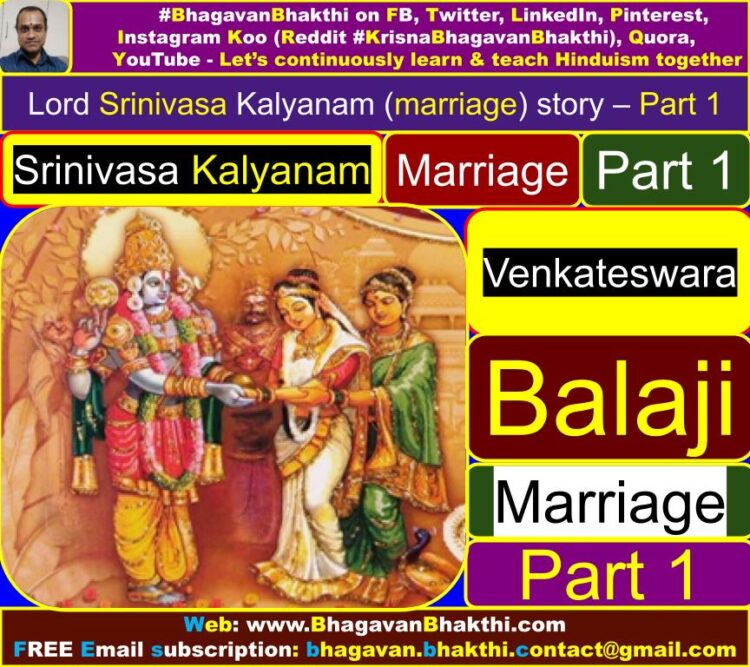
Background: In Kali Yuga Bhagavan Lord Sri Vishnu takes an avatar as Lord Sri Srinivasa (Venkateswara) (Venkatesha) (also known as Balaji), while Sri Vedavati Devi takes avatar as Sri Padmavati Devi.
The grandest and greatest kalyanam (kalayana) (kalayan) (vivaham) (vivaha) (vivah) (marriage) between Lord Sri Srinivasa (Venkateswara) (Lord Balaji) and Goddess Sri Padmavati Devi took place with all divine presence of all Devatas (Demigods).
Bhagavan Lord Sri Srinivasa’s mother name is Bakula (Vakula) Devi.
In the Dwarapa Yuga, same Bakula (Vakula) Devi was non other than Yashoda Devi (Bhagavan Lord Sri Krishna’s foster mother).
In this avatar Yashoda Devi had requested Lord Sri Krishna that since she had not seen the vivaha (kalyana) (divine marriage) of Lord Sri Krishna, she want to see the same.
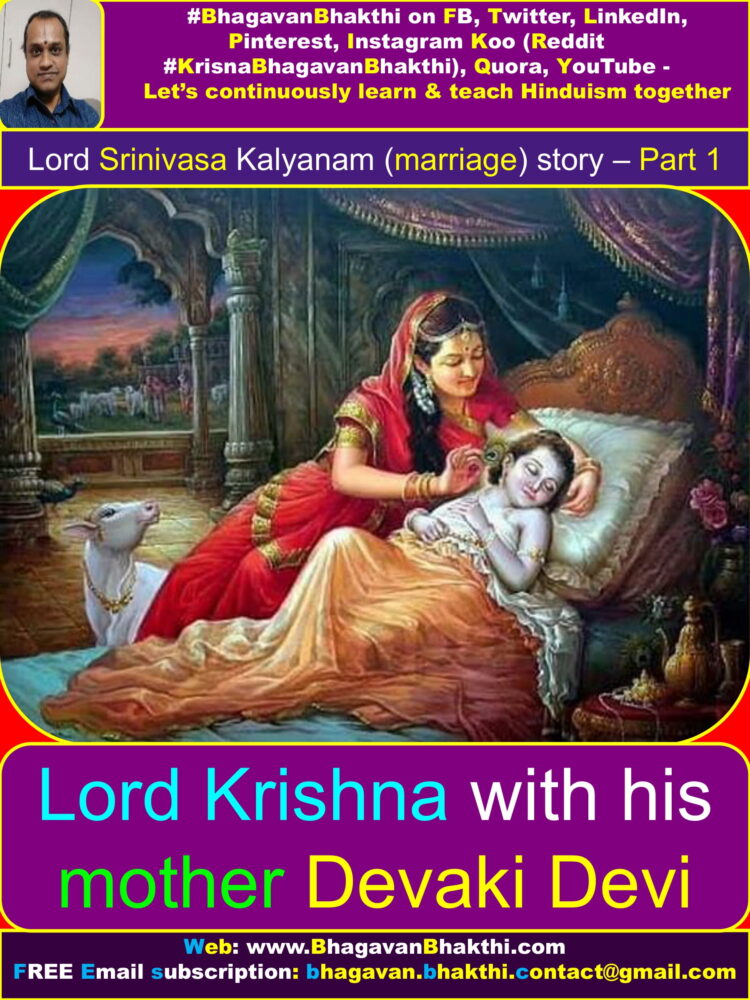
Thus Lord Sri Krishna had promised that in the Kali Yuga, he will take avatar as Lord Sri Srinivasa (Venkateswara) (Balaji) and she will be reborn as Bakula (Vakula) Devi.
And thus Bakula (Vakula) Devi will have the divine chance to watch the full vivaha / kalyana (divine marriage) of Lord Sri Srinivasa.
Thus Yashoda Devi (Bakula Devi) was blessed to witness to watch the divine marriage of Lord Sri Srinivasa with Padmavati Devi.
Let’s know how this divine marriage took place and what are it’s significances are as given below:
Prathama / First Adhyaya
ब्रह्मरुद्रादिवंद्यं त्वां भजे वेंकटनायकं । निवारयस्वानिष्ठानि साधयेष्ठानि माधव ।
ಬ್ರಹ್ಮರುದ್ರಾದಿವಂದ್ಯಂ ತ್ವಾಂ ಭಜೇ ವೇಂಕಟನಾಯಕಂ | ನಿವಾರಯಸ್ವಾನಿಷ್ಠಾನಿ ಸಾಧಯೇಷ್ಠಾನಿ ಮಾಧವ |
brahmarudrādivandyaṁ tvāṁ bhajē vēṅkaṭanāyakaṁ | nivārayasvāniṣṭhāni sādhayēṣṭhāni mādhava |
The story of Lord Sri Srinivasa (Venkateswara) (Venaktesha) (Balaji) Kalyana (marriage) story was written by Lord (Sage) Sri Veda Vyasa Ji, through commentary of Sri Shaunaka Rishi and Sri Sutacharya Ji.
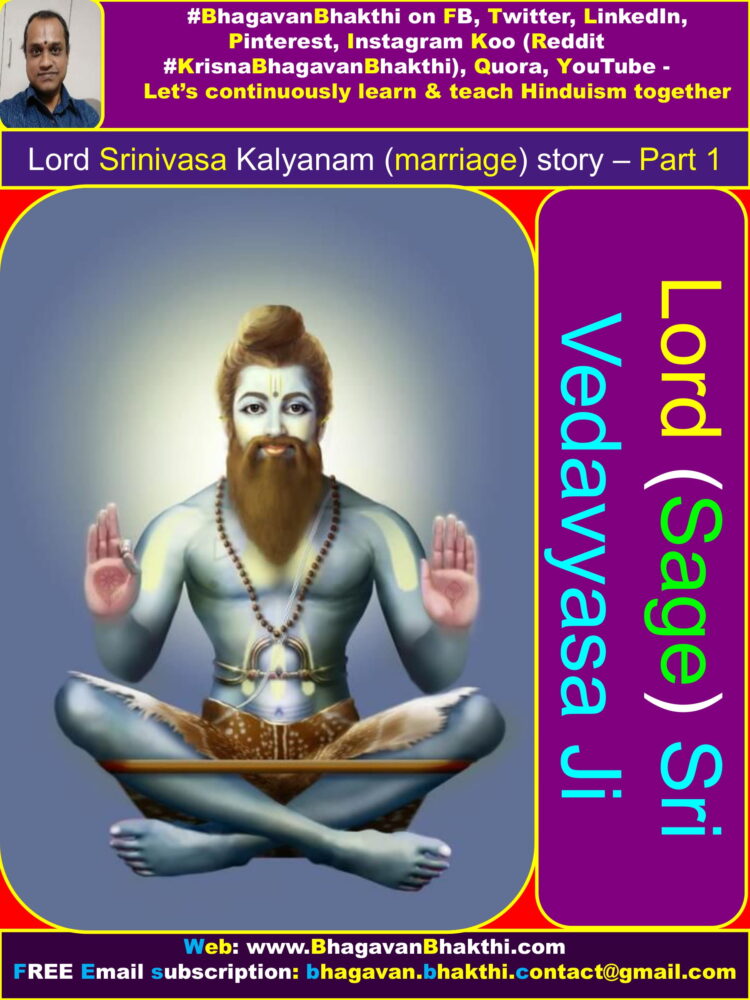
(We should always remember that Sri Veda Vyasa Ji is svayam Bhagavan & avatar of Lord Sri Vishnu and doesn’t need any help from anybody.)
(This is only a vidambana / nataka / drama / pastime done by Lord (Sage) Sri Veda Vyasa Ji to show the greatness of both Sri Shaunaka Rishi and Sri Sutacharya Ji.).
It is a conversation between Sri Shaunaka Rishi and Sri Sutacharya Ji.
Once, Sri Shaunaka Rishi asked Sri Sutacharya Ji to tell about Greatness of Lord Sri Srinivasa (Venkateswara) (Balaji).
For this Sri Sutacharya told him that he will tell what he had heard from Bhagavan (Sage) Sri Veda Vyasa Ji.
Once there lived a king by name Seeradhvaja (Sīradhvaja) (Janakaraja, that is, the father mother Sri Sita Devi), who was a very good administrator.
Seeradhvaja (Sīradhvaja) was sarva shastra pandita (knows all the Hindu texts and also knows about all the shastras).
Seeradhvaja (Sīradhvaja) was not at all getting any anger and also was free of ahankara / arrogancy.
Seeradhvaja (Sīradhvaja) had a bhrata / brother by name “Kushadhvaja”.
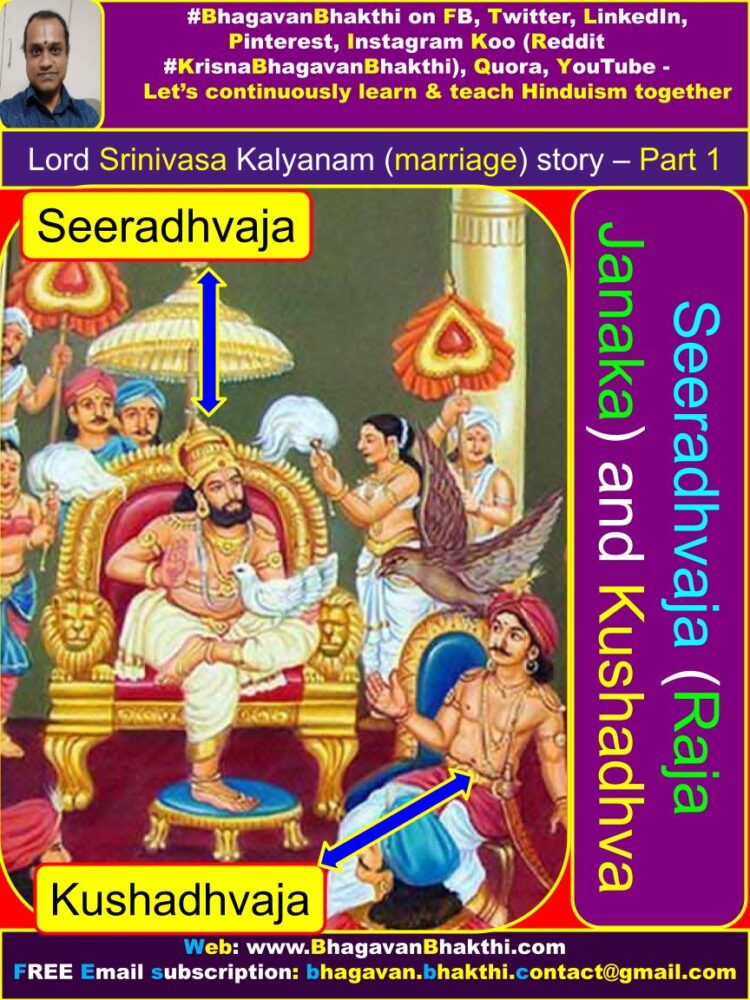
Seeradhvaja / Janaka Maharaja had a daughter in the form Saakshat Sri Maha Lakshmi Devi by name “Janaki” (that is mother Sri Sita Deva).
One day Seeradhvaja brother Kushadhvaja died and his wife followed him.
Even after 80,000 years, Seeradhvaja had never faced any sorrow throughout this time span.
But now, Seeradhvaja started to face sorrow with the death of brother Kushadhvaja.
At this time Rishi Shatananda came near Janakaraja. Then Janakaraja told the Rishi Shatananada that now he is very aged, and he has unmarried children.
Also continued that, Ravana, Kumbhakarna are trying to kidnap his children.
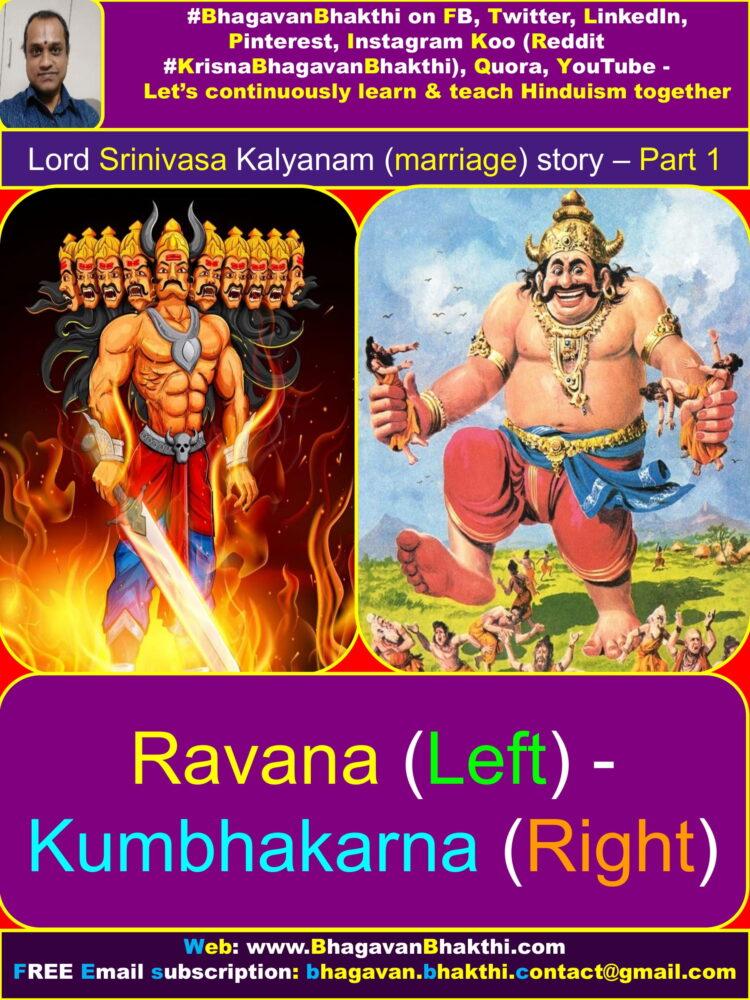
Because of this reason, he is under depression and sorrow about three main things, that is.,
1. At this age, how can I (Seeradhvaja) fight with Ravana, Kumbhakarana etc.
2. Seeradhvaja is worried about daughter Sri Sita Devi, that is, how to find a suitable groom to her.
3. As Seeradhvaja had lost his brother Kushadhvaja, Seeradhvaja has to get marry all four daughters including his brother Kushadhvaja’s daughter, that is –
Mother Sri Sita Devi, Sri Urmila Devi, Sri Mandavi Devi and Sri Shrutakeerti Devi.
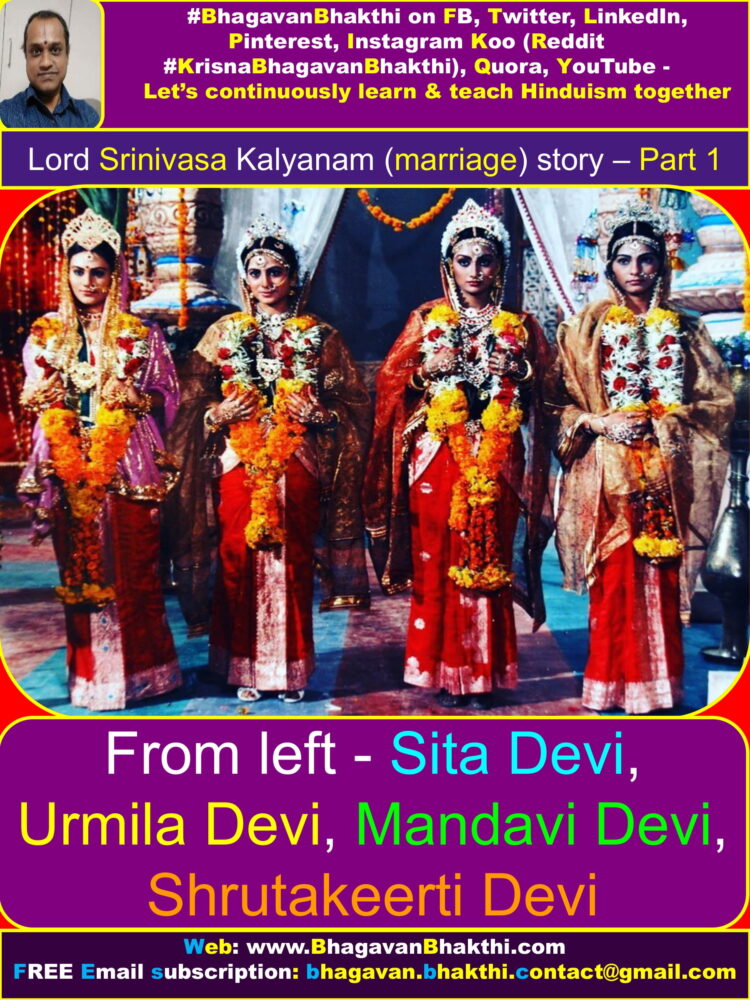
Seeradhvaja has to give all the four daughters to the sons of a single king.
Seeradhvaja asked Rishi Shatananda as to how these can be fulfilled.
Rishi Shatananda told it is better to hear the Bhavishya Purana’s Vaikuntha Parva Mahima (greatness).
In Kali Yuga, by hearing this all the sorrows will be removed.
By hearing this, Lord Sri Brahma Deva got the Great Brahma padavi.
By hearing this, Lord Shiva lost the Samudra manthana Visha Baadha (problems that came during the consumption of poison during the samudra manthana).
By hearing this, Lord Sri Indra Deva became the king of Svarga Loka.
In this way Rishi Shatananda started to tell Janakaraja about the Greatness of Venkatachalam (Today’s Tirupati / Tirumala).
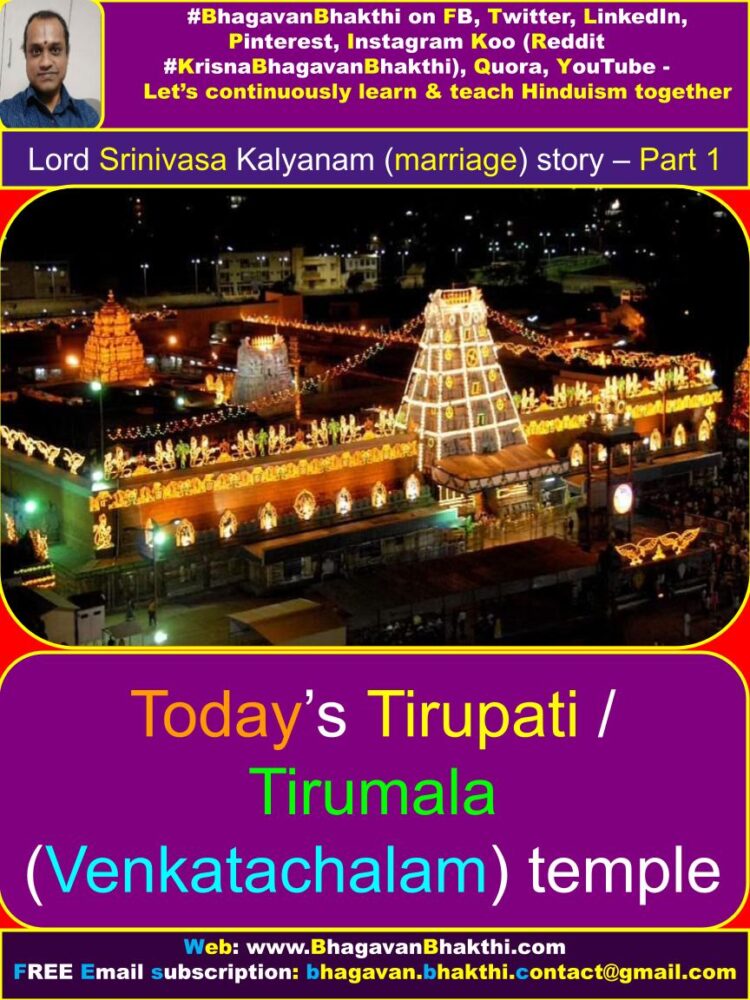
Tirupati (Venkatadri) (Venkatachalam) hills names in different yugas:
1. In Krita Yuga / Satya Yuga, it’s name was “Vrishabachala”. This name came because Lord Sri Vishnu defeated the asura Vrishabasura.
2. In Treta Yuga, it’s name was “Anjanachala”. This name came because Sri Anjana Devi, that is, the mother of Anjaneya (Hanuman) done the penance in this hill.
3. In Dvapara Yuga, it’s name was “Sheshachala”. This name came because Sri Adishesha Naga was defeated by Sri Vayu Deva.
This fight was fought as Sri Adishesha Naga had the Asuravesha (Demon like thinking) inside him.
And because of this Asuravesha (Demon like thinking), Sri Adishesha Naga (serpent) had started to think himself to be greater than Sri Vayu Deva.
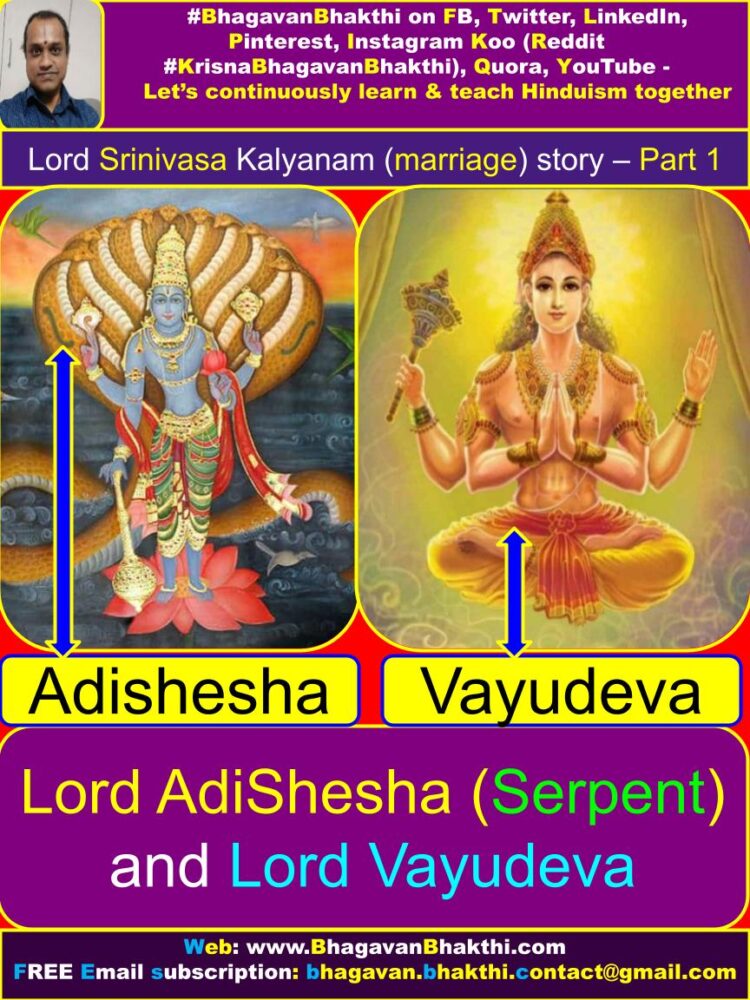
To nullify this Asuravesha (Demon like thinking), Sri Vayu Deva defeated Sri Adishesha Naga.
And thus the Asuravesha (Demon like thinking) of Sri Adishesha Naga was suppressed by Sri Vayu Deva.
(Please remember that Sri Vayu Deva will become the Lord Sri Brahma Deva in the next Kalpa.)
(Lord Sri Hanuman, Sri Bhimasena and Sri Madhvacharya Ji are the avatars of Sri Vayu Deva).
4. In Kali Yuga, it’s name is “Venkatachalam (Venkatadri)”. This name came because Sri Venkateswara (other name of Lord Sri Srinivasa / Balaji) gets married with Goddess Sri Padmavati Devi.
Why Vrishabachala name in Krita Yuga / Satya Yuga
In Krita Yuga / Satya Yuga there lived an asura (demon) and his name was Vrishabasura.
Vrishabasura used to cause problems and nuisance to munis (Monks / Rishis) and other sajjanas (Divine people) who were doing the yagna, yaaga, etc.
For this reason, the muni (Monks / Rishis) and sajjanas (Divine people) approached Lord Sri Vishnu for help.
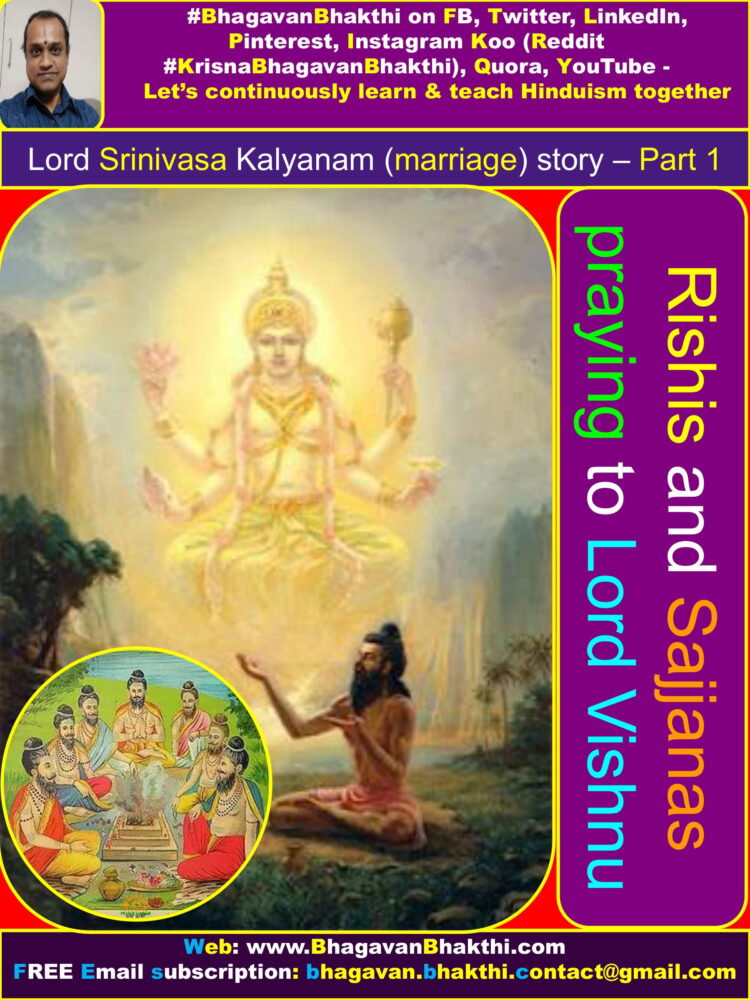
This asura (demon) Vrishabasura used to worship Lord Sri Narasimha’s Shaligrama daily by having trikala (three time) snana / bath with full bhakti (devotion).
After the pooja, Vrishabasura used to offer his own head by cutting from his sword to Lord Sri Narasimha.
But, here every time Vrishabasura was cutting his head, the head used to come back immediately. Vrishabasura did like this for 5,000 years.
Lord Sri Vishnu came near Vrishabasura, and this asura (Demon) did the full shastanga namaskara to Lord Sri Vishnu.
Lord Sri Vishnu asked him to seek some boon. But this asura (demon) asked Lord Sri Vishnu to fight with him as a boon.
Lord Sri Vishnu accepted this and fight started between Vrishabasura (Also with his army) and Lord Sri Srinivasa (Lord Sri Vishnu).
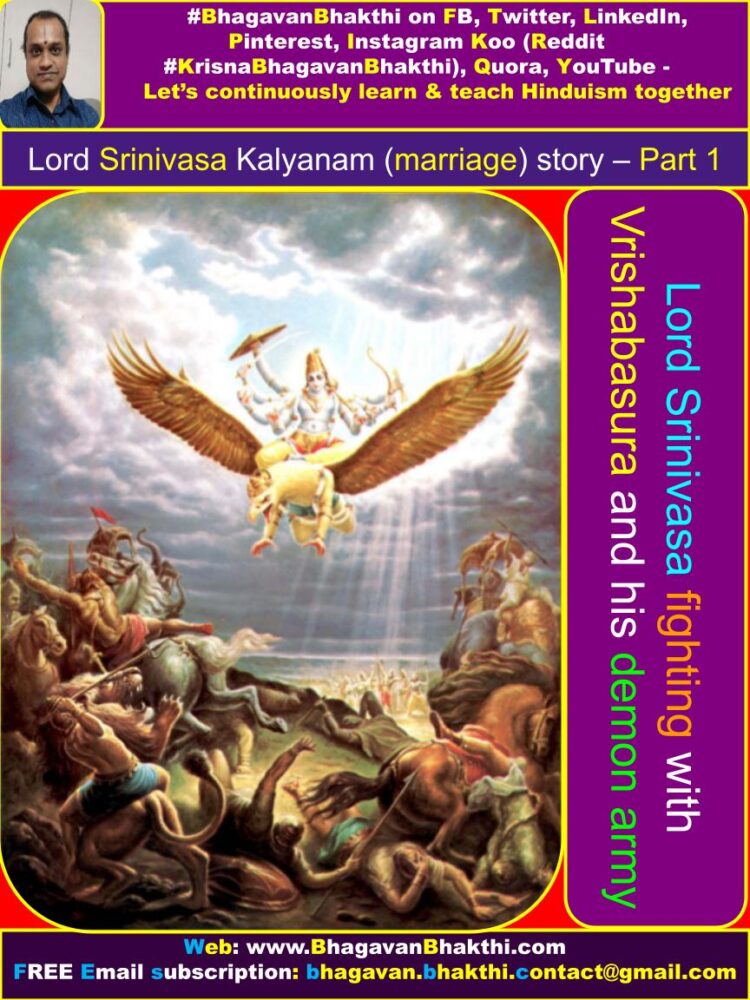
Whatever Lord Sri Srinivasa (Lord Sri Vishnu) used to do, this asura (demond) also used to do the same thing.
Thus Lord Sri Vishnu asked Sri Garuda Raja to come, and Lord Sri Vishnu sat on the Great bird Sri Garuda Raja and removed Vrishabasura’s head with Lord Sri Vishnu’s Sudarshana Chakra.
Before his death, Vrishabasura asked Lord Sri Vishnu to keep his name for the parvata / hill where he stayed for so long.
Our Lord Sri Vishnu is called Karunasagara. Thus Lord Sri Vishnu accepted this request and kept the name as Vrishabadri (Vishabachalam).
Thus in Krita Yuga / Satya Yuga, that parvata / hill was called as Vrishabadri (Vrishabachalam).
Background of this asura (Demon) Vrishabhasura
Usually in everybody at least two jeevis (beings) live. One will be dharmika (follower of Dharma) and another will be adharmi (Opposer of Dharma).
Similarly in Vrishabhasura also, there used to live two jeevis (jeevadhvaya avesha), that is, one was “Dharma”, who in Vaivasvata Manvantara was living,
who did the penance to Lord Sri Varaha Svamy (Also called as Bhu Varaha Swamy) and Lord Sri Varaha Svamy blessed him and thus his name was used as the name of the parvata / hill. The name was called “Vrishabha”.
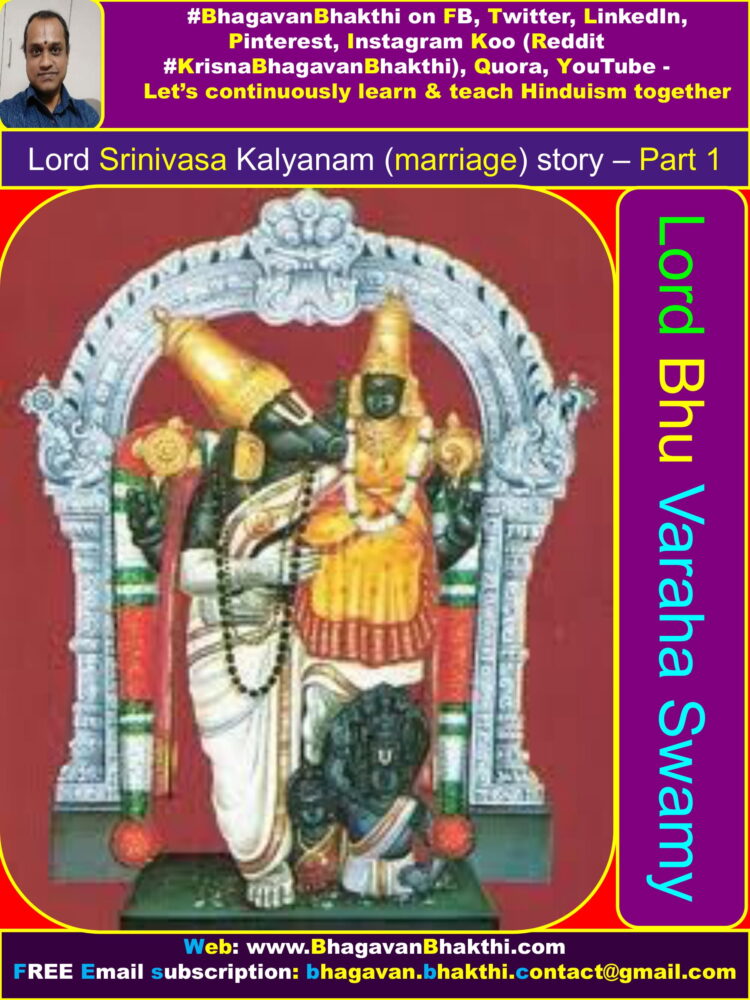
The other is Vrishabhasura, an asura (demon).
Only because the jeeva Dharma was there inside one jeevavesha, this asura used to do Shaligrama shila pooja (that is pooja of Lord Sri Vishnu in Shaligrama), with trikala (three time) snana / bath.
Also, because Vrishabhasura was having Rakshasavista (avesha / presence of Rakshasa), he used to cause problems and nuisance to Rishis, Munis, Sajjanas etc.
Why Anjanadri name in Treta Yuga
During Treta Yuga there lived an asura (demond) named Kesari. Kesari was a devotee of Sri Vayu Deva.
Kesari prayed the antaryamai of Lord Shiva, that is Lord Sri Vishnu by doing tapas.
When Lord Sri Vishnu came in front of Kesari, Kesari asked to give him a son who will be a great devotee of Lord Sri Vishnu.
Lord Sri Vishnu told him that since Kesari does not have the yoga of a son, he will give him a daughter, and in her he will get grand son, who will be a devotee of Lord Sri Maha Vishnu.
After some time, this Kesari got a daughter.
Since this daughter removed her father’s eye problem, she was called as “Anjana”.
Anjana was married to another monkey King named Kesari.
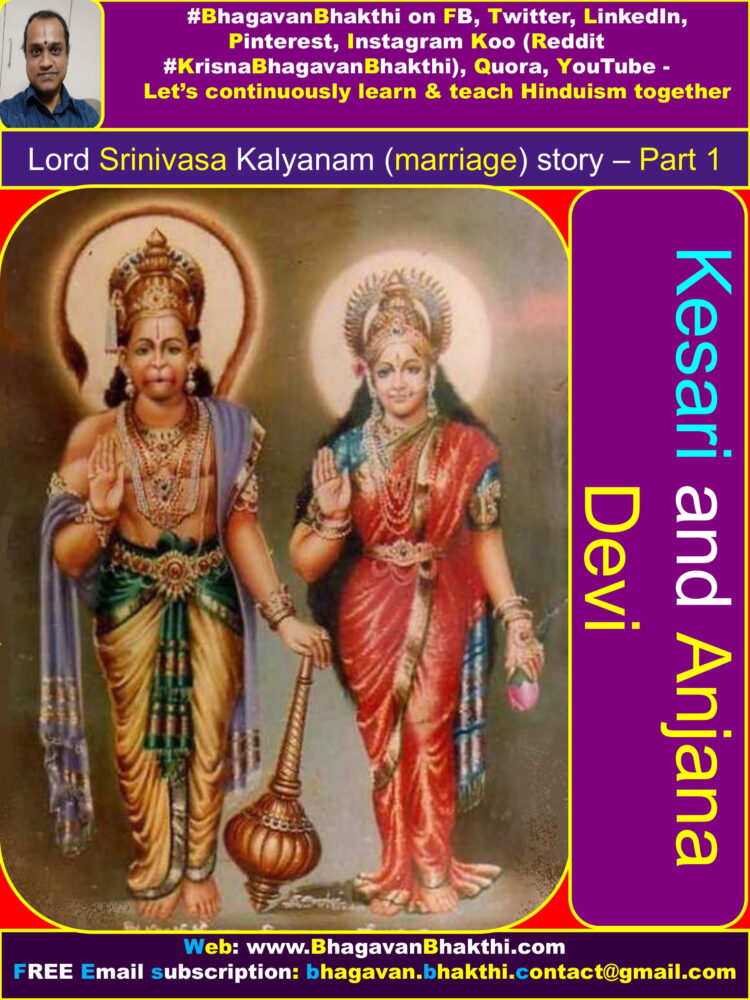
This Kesari had killed Shambasadhana named asura (demon), who was giving trouble to Rishis.
Pleased with the killing of the asura (demon), again the Rishi also blessed him with a Bhagavatottama putra (a son who is best among the Lord Sri Vishnu devotees).
While, Anjana did the tapas for 12 years in a hill called Narayana Parvata, as advised by Maharshi Matanga.
Anjana got the permission of her husband and Rishis and used to do bath in Swami Pushkarini and was also doing Ashvattha Pradakshina (circling of the Ashvattha tree).
With this Anjana was also doing Lord Sri Varaha Svamy darshana, and Tirthodaka paana (Drinking Tirtha water).
With this Anjana was also observing fast and had kept aside all bhoga and did the penance.
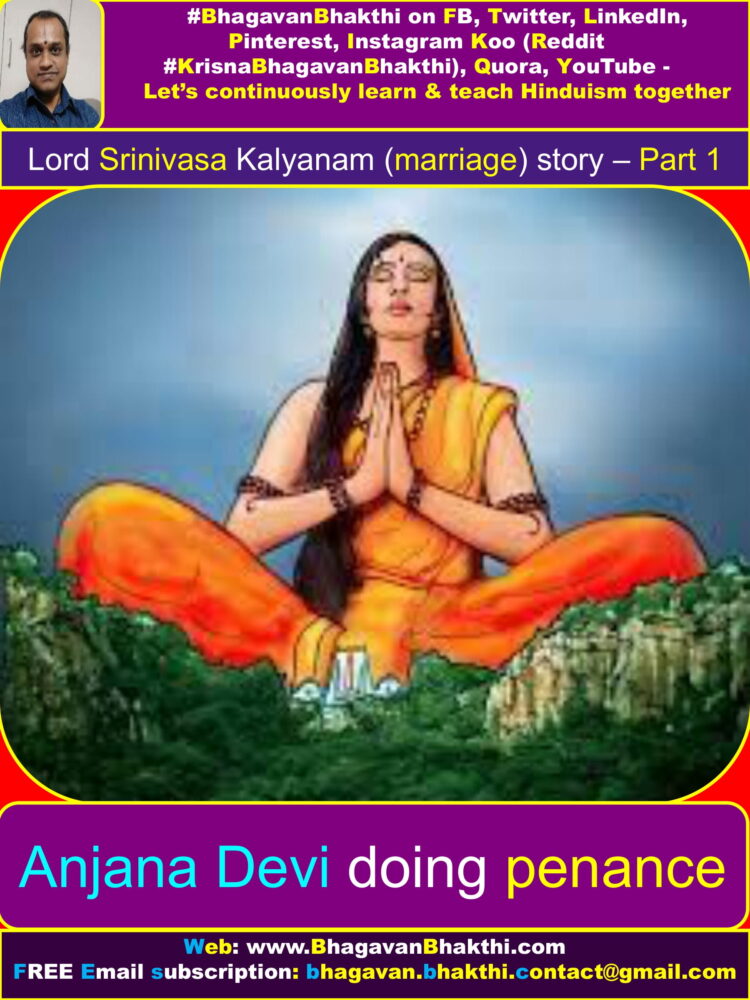
After completion of one year, Sri Vayu Deva used to come daily and was giving a fruit daily to Anjana.
Sri Vayu Deva, one day gave the fruit with his “veerya” and also did the anugraha and blessed Anjana.
During her Penance period, she used to take only wind as her food and nothing else.
Anjana did the penance for 12,000 abdhi kaala.
After this, Anjana got garbha dharana (pregnant) and Anjana gave birth in her 10th month of garbha dharana. This child was named as “Hanuman / Hanumanta”.
In this way, since Anjana did the penance for a long period in this mountain, thus this mountain came to be known as “Anjanachalam / Anjanadri”.
Why Sheshachalam name in Dvapara Yuga
In Dvapara Yuga, once Lord Sri Vishnu, asked Sri Adishesha Naga to guard Vaikuntha dvara / gate and Lord Sri Vishnu was with Goddess Sri Maha Lakshmi Devi.
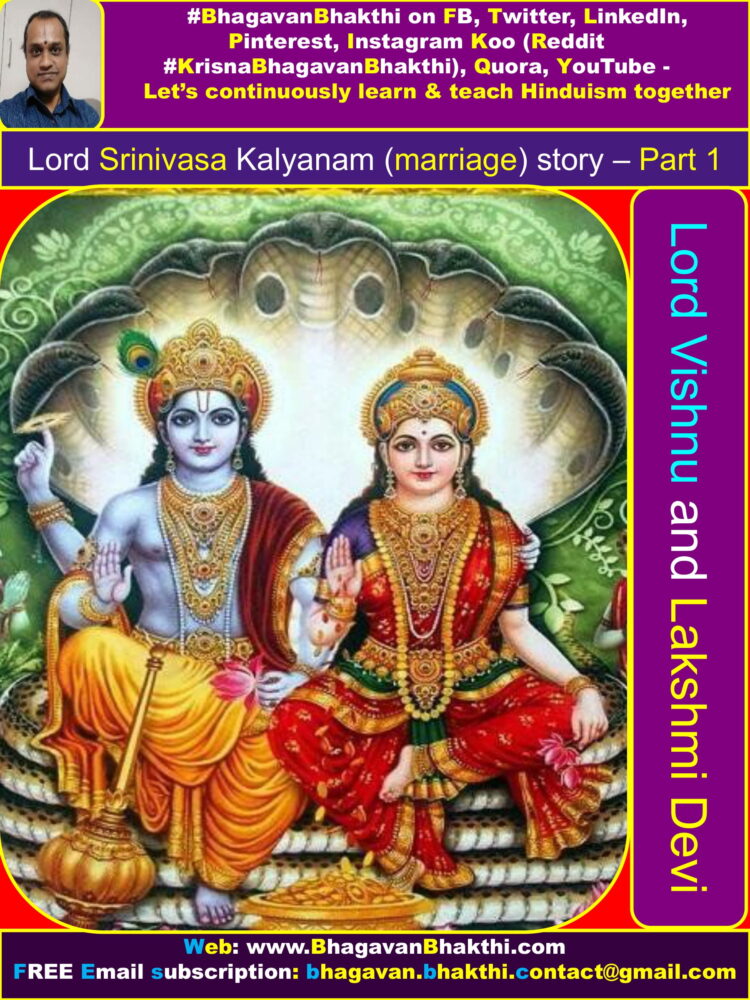
At that time, Sri Vayu Deva came there to see Lord Sri Lakshmi Narayana.
But Sri Vayu Deva was stopped by Sri Adishesha Naga, who had kali avesha (Kali Yuga’s Kali) inside him at that time.
Sri Vayu Deva who never ever makes any mistake (Remember that Sri Vayu Deva is the same as Sri Hanuman / Sri Bhimasena / Sri Madhvacharya Ji) reminded Sri Adishesha Naga about what had happened when Jaya-Vijaya stopped Sanaka, Sanandana, Sanatana Sanatakumara sages.
Sri Adishesha Naga told Sri Vayu Deva that he is the shayana / bed of Lord Sri Vishnu and he is the supreme than Lord Sri Brahma Deva and Sri Vayu Deva.
For this Sri Vayu Deva said Sri Adishesha Naga that, even though a cat enters the bed of the king, it can’t be superior than an elephant standing outside.
When the conversation between Sri Vayu Deva and Sri Adishesha Naga continued for long period, Lord Sri Maha Vishnu came before them, and asked them about the issue.
Lord Sri Vishnu suggested to test who is supreme between the two.
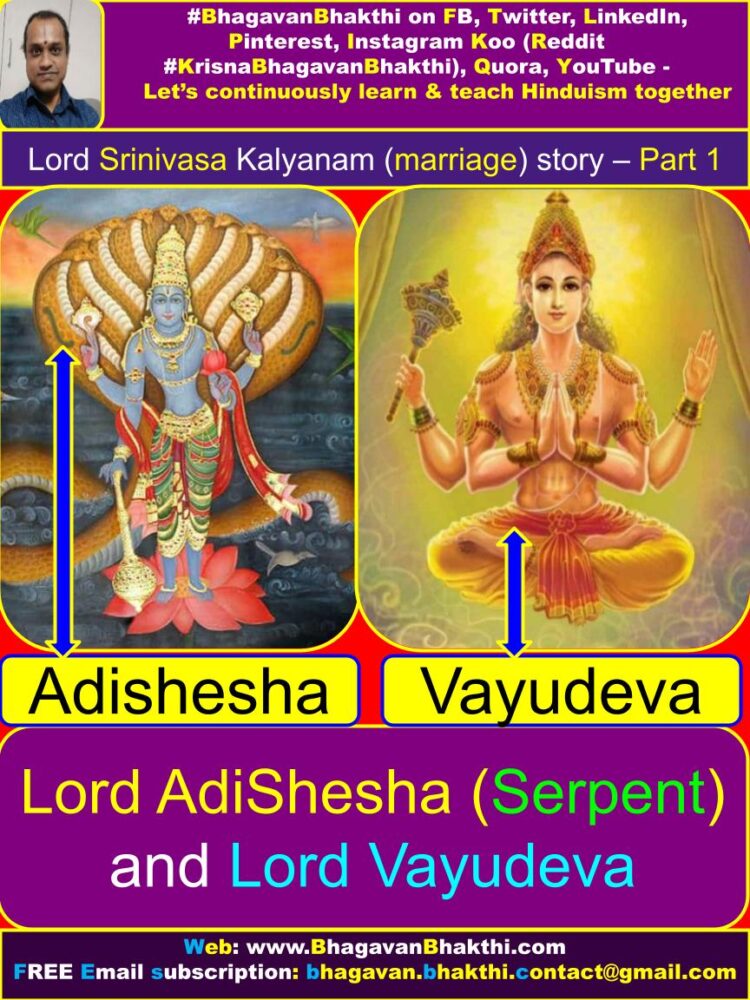
Lord Sri Vishnu told Sri Adishesha Naga to tie Anandadri hill (son of Meru hill), with his body as the rope as tightly as possible.
Lord Sri Vishnu asked Sri Vayu Deva to move the mountain to test who is supreme amongst them.
With this Sri Vayu Deva just touched it very softly (sparsha) with his single finger, and with this soft touch Anandadri was moved over 51,000 yojana near Suvarnamukhi river basin.
In this way, Sri Vayu Deva was declared as supreme than Sri Adishesha Deva.
After this, Sri Adishesha Deva, confessed before Sri Vayu Deva, who in turn blessed him.
In this way, this mountain was given the name Sheshachalam named after Sri Adishesha Deva, who was defeated in the fight with Sri Vayu Deva.
[Here, Sheshachalam = Shesha + a + chalam = Lord Adishesha + Can’t + Move = Lord Adishesha was not able to move this hill and thus it is called as Sheshachalam.]
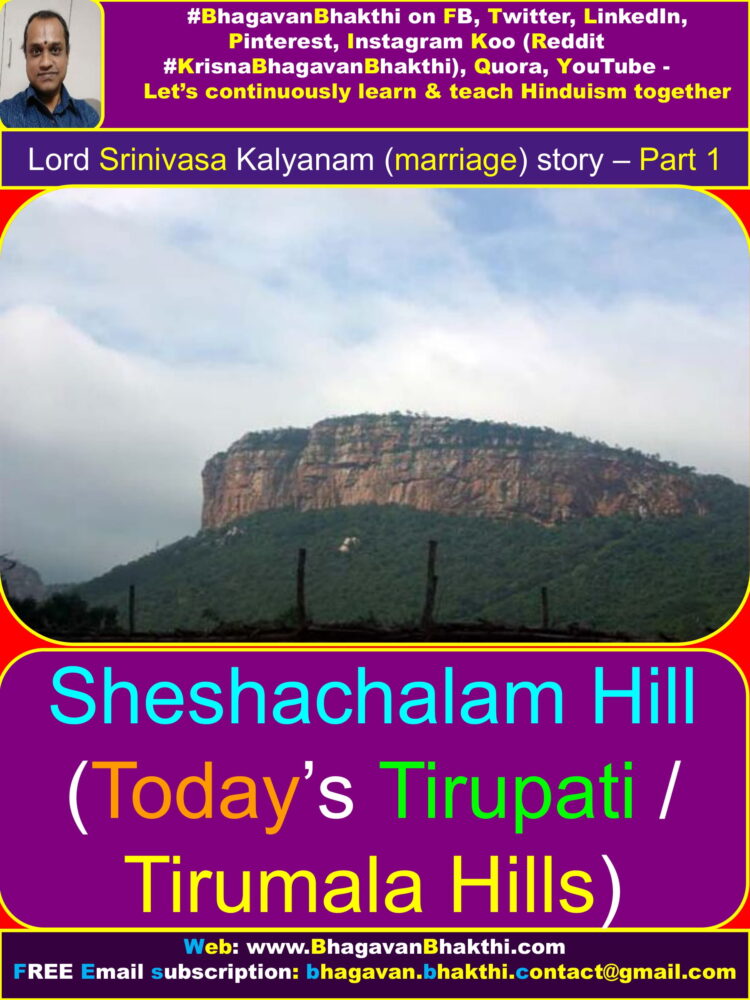
Why Venkatachalam name in Kali Yuga
वें पापं कटते यस्मात्पादाहन शक्तित: । वेंकटाचल इत्येव नाम देवास्तदा जगु: ।
ವೇಂ ಪಾಪಂ ಕಟತೇ ಯಸ್ಮಾತ್ಪಾದಾಹನ ಶಕ್ತಿತ: | ವೇಂಕಟಾಚಲ ಇತ್ಯೇವ ನಾಮ ದೇವಾಸ್ತದಾ ಜಗು: |
vēn pāpaṁ kaṭatē yasmātpādāhana śaktita: | vēṅkaṭācala ityēva nāma dēvāstadā jagu: |
As Lord Sri Vishnu came from Vaikuntha and stayed on this mountain, this place came to be known as Venkatachalam (Venkatadri) in Kali Yuga.
Once upon a time, there lived a Brahmana (Brahmin) and his name was Purandara in a place called Kalahasti.
Brahmana (Brahmin) was a truthful, he was well maintaining brahmanatva (principles of Brahmana), also he was doing soma yagna.
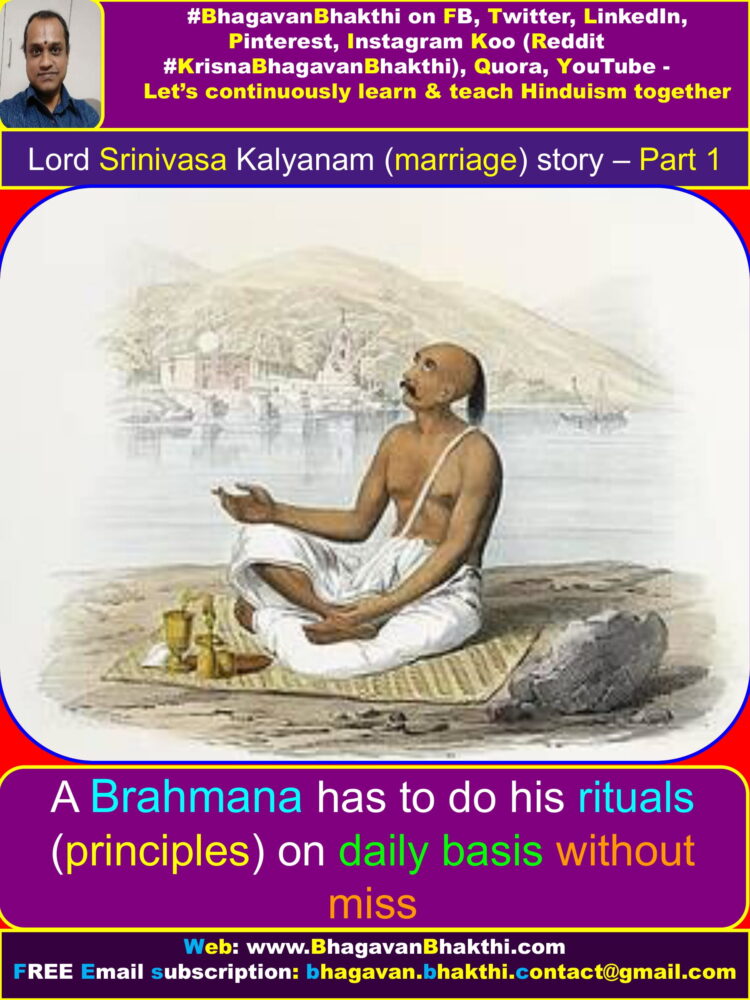
This Brahmana (Brahmin) neither had any children nor any wish for children.
Brahmana (Brahmin) was not even bothered that he was childless.
But still this Brahmana (Brahmin) got a son at his old age, and this child’s name was “Madhava”.
Madhava got Upanayana (A ritual) at his age of eight, Madhava got all types of education.
And Madhava was well versed in Chaturveda (Rid Veda, Sama Veda, Atharvana Veda, Yajur Veda), Shiksha, Vyakarana, Chandassu, Jyotishya, Meemaamsa and also other / sakala shastras.
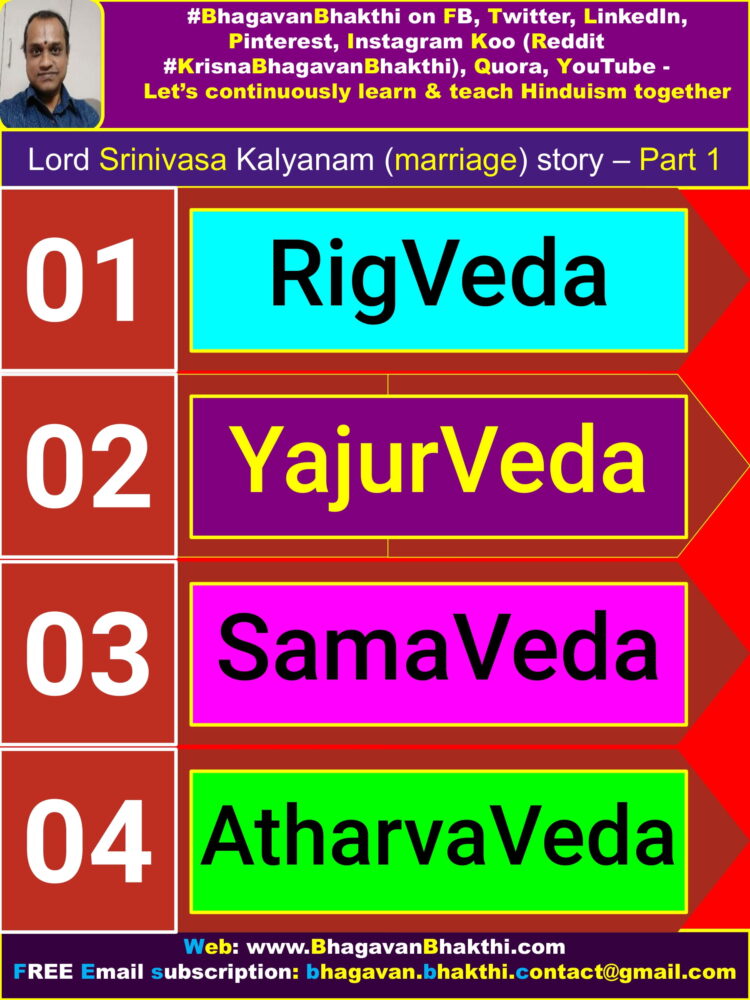
Madhava got married with a girl called Chandralekha.
Chandralekha was a pativrata, and was assisting her husband in all his yaaga, yagna and other kaaryaas / works.
One fine day, Madhava Brahmana wished to get intimate with her in the morning time itself.
But the pativrata naari / woman Chandralekha said that this is not correct according to Dharma, as there are so many Rishis and their aged parents at their place.
Getting intimate in the morning is against Dharma as per Sanatana Dharma.
But Madhava Brahmana insisted that they shall get intimate, so Chandralekha told him as the parents are there, let us go out somewhere and get intimate somewhere faraway from the house.
Saying this, Chandralekha went out with a vessel to bring water.
Madhava Brahmana also followed her and reached a park nearby.
There, Madhava Brahmana saw a beautiful woman, whose name was “Kuntala” and this woman was from a lower caste.
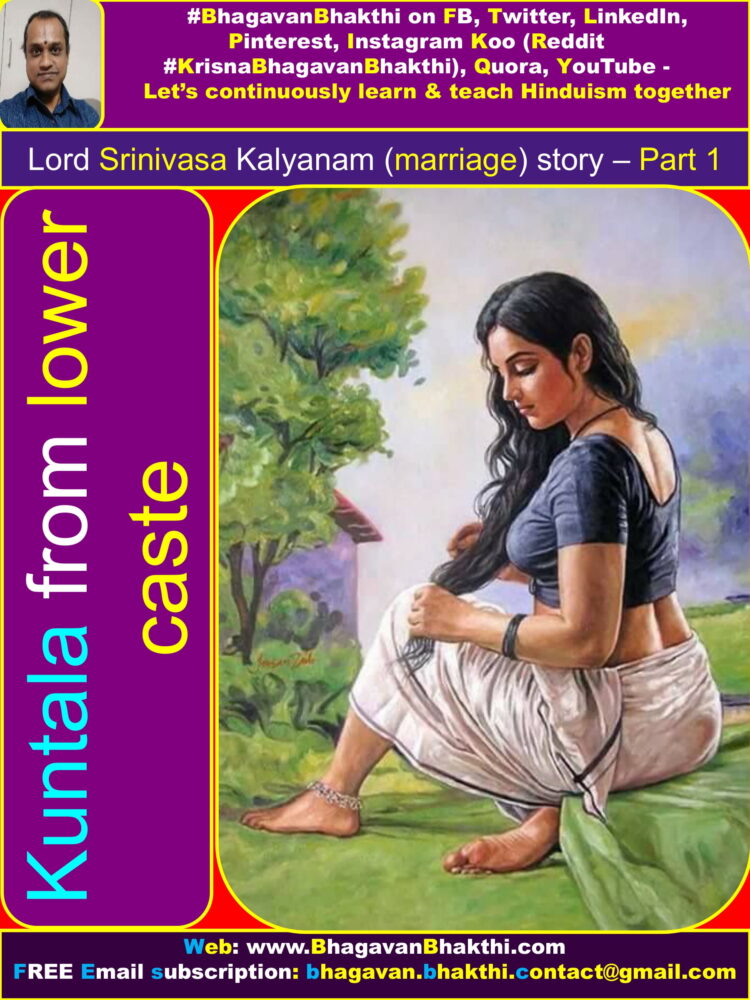
As soon as Madhava Brahmana saw Kuntala, he was attracted by her beauty and asked his wife to go home.
As soon as Madhava Brahmana’s wife went home, Madhava Brahmana came near this woman and enquired about her name, father, place, caste, etc.
Madhava Brahmana also asked her to marry him.
But, she told that she is from a lower caste and that too from a Chandala family.
She eats meat and drinks alcohol and told him not to come near her.
Kuntala told Madhava Brahmana, that you are a Brahmana, who has studied Vedas, shastras etc. and not suitable for him to marry her.
But Madhava Brahmana forced Kuntala to marry him.
Kuntala told Madhava Brahmana that as she is from a Chandala family, by touching or getting intimate with her will result in Naraka Loka.
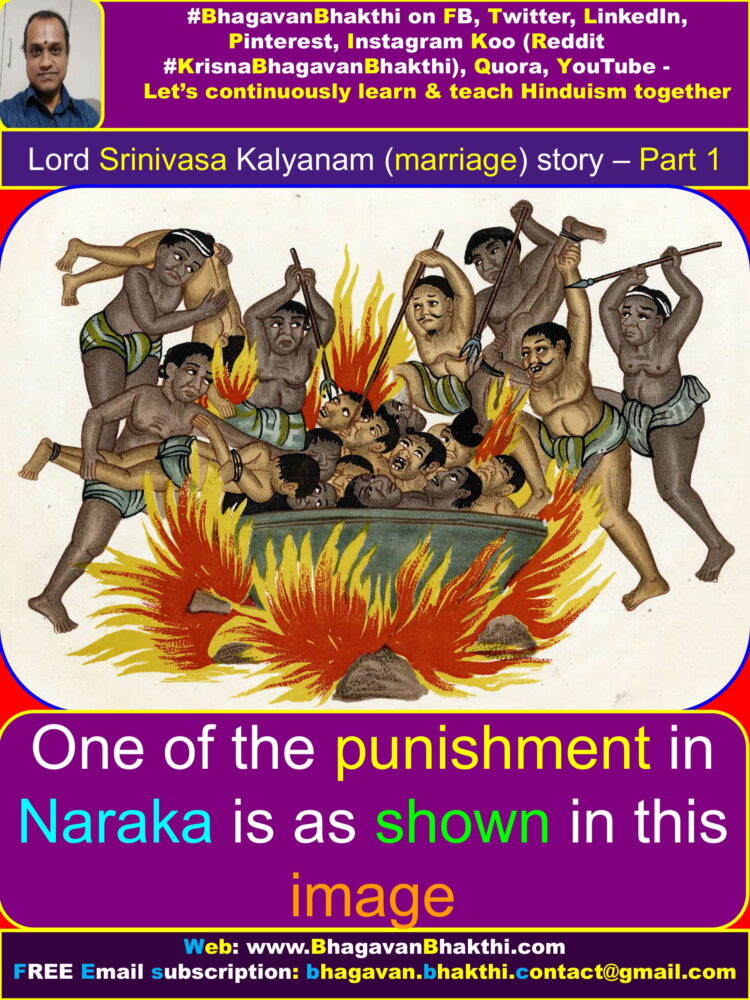
Kuntala told Madhava Brahmana that as you are a Brahmana, you have all the samskaras (rituals) like:
Jata samskaran, jaatakarma, naama karana, annaprashana, choula, upanayana, agnisakshi vivaaha, vedadhyana, nitya deva pooja, Vishnu nivedita anna, etc.
Also Kuntala told Madhava Brahmana that her legs are pashana sama (legs are equal to poison) as she is a prostitute.
So saying thus, Kuntala tried to run away.
But Madhava Brahmana chased her and held her and forcibly raped her.
Then Kuntala told him that you have lost your Brahmanya (now Madhava is not a Brahamana)), and asked Madhava to remove the Yagnopaveeta, remove the Shikha, gave him Gomaamsa (beef) for eating.
Also, Kuntala gave wine to Madhava for drinking, and thus Madhava stopped all Brahmanya karmas (Rituals done by Brahmana) and stayed with her for 12 years.
Madhava did not even go to his house too.
After 12 years of his stay with Kuntala, Kuntala died and at this point now Madhava realized his own mistake.
At the same time a king and his army of people from northern India came touring towards Varaha parvata (hill).
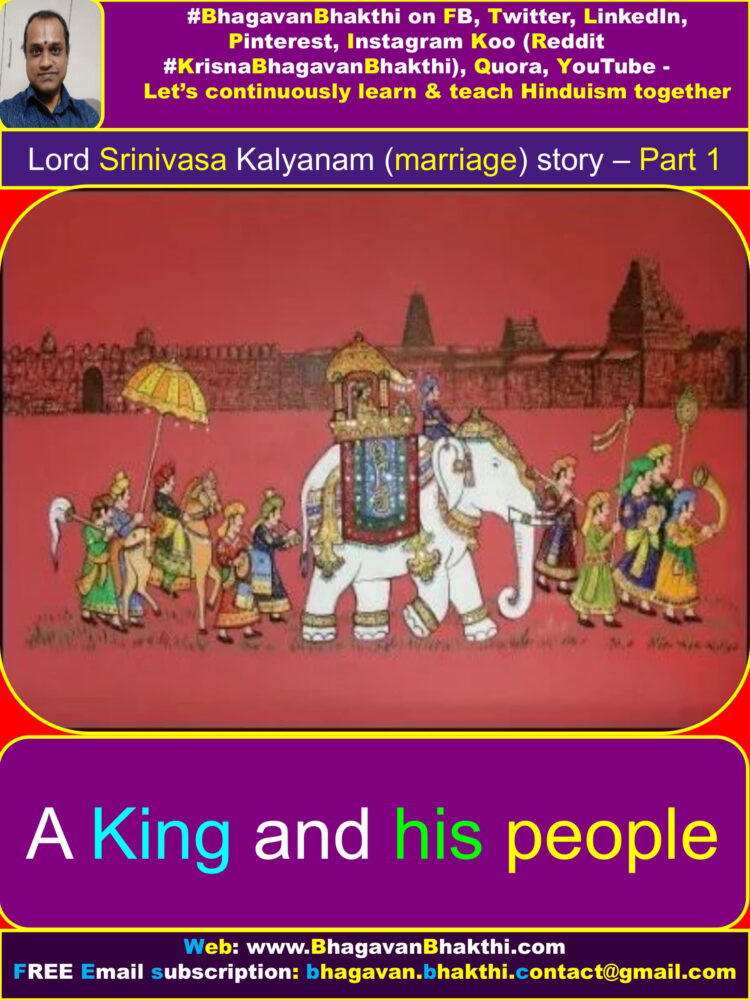
This Madhava used to follow them, and used to eat the leftover of these people.
Madhava followed them to Shesha parvata (hill) also.
In Shesha parvata (hill), those kings’ men did the snana / bath in Kapila Tirtha, did sankalpa, got keshavapana (hair removal).
Again had snana / bath, gave pitru pitaamahaadi paarvana shraaddha.
Seeing all these, Madhava also followed them, did snana / bath, vapana, punaha (again) snana / bath etc.
Madhava did snana (bath) in Kapila Tirtha, and gave pinda made of mud and did pinda pradhana.
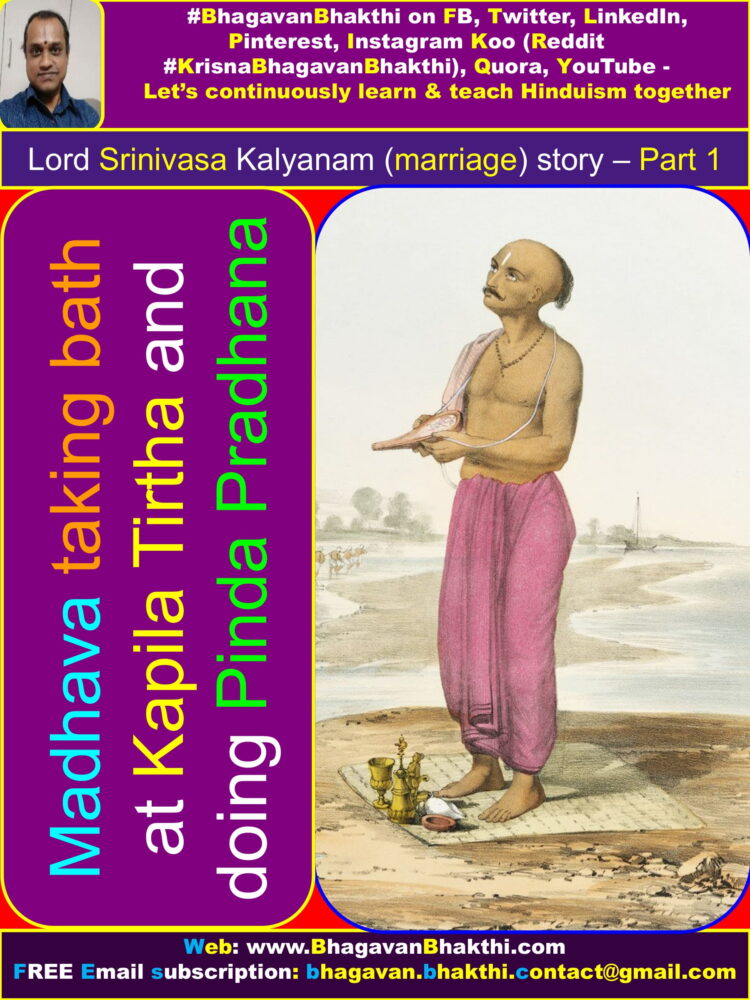
By doing so, Madhava lost all the paapa karma.
Those who do Pitru Shraaddha, pinda pradhana in Kapila Tirtha in Vaikunthagiri will get moksha.
Madhava Brahmana did so in Vaikuntha parvata by giving pinda pradhana.
Next day, this Madhava Brahmana climbed the Venkatagiri by walking following those Kings’ men.
Wherever these Kings’ men were going, they used to do the kathana (telling the stories) of Lord Sri Vishnu in Garudadri, Anjanadri, etc.
As soon as Madhava Brahmana entered Venkatadri, by sparsha / touch itself his Kuntala’s sahavaasa paapa phala (fruits of companionship with Kuntala),
Matru-Pita-patni tyaga paapa phala (mother-father-wife’s sacrifice fruits), maamsa bhakshana (meat eating),
Madya bhakshana papa (sin of drinking alcohol) all were burnt by the agni (fire) born in his body itself through vomiting.
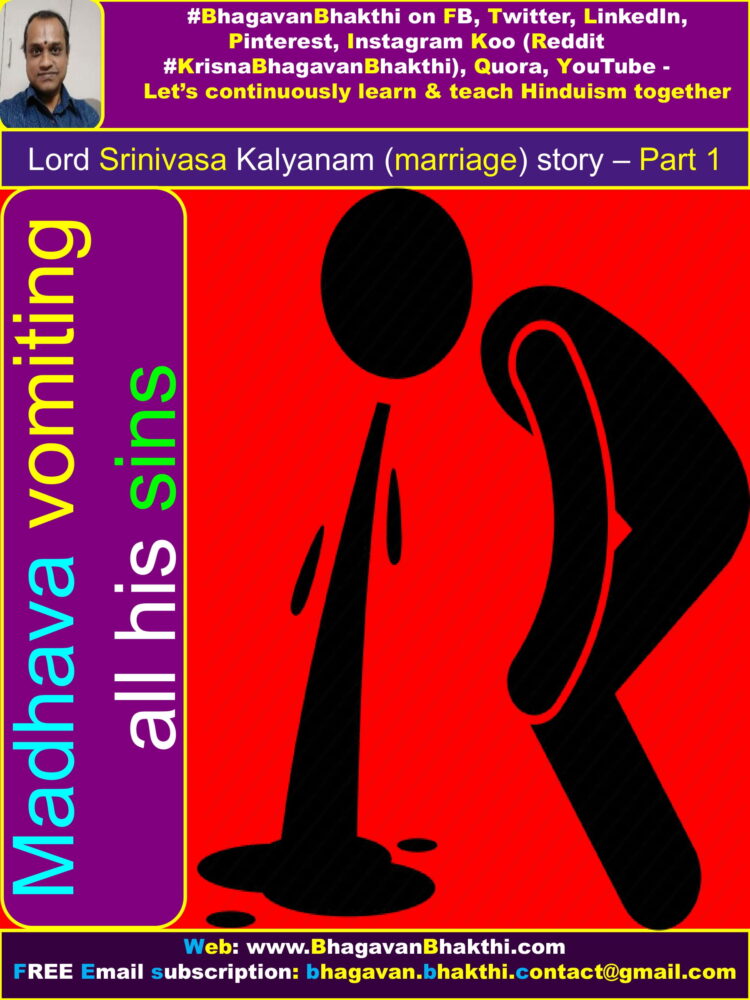
Then Lord Sri Brahma Deva came near Madhava Brahmana and asked him to take bath in Svami Pushkarini Tirtha and do namaskara to Lord Sri Bhu Varaha Svami’s deity and finally Madhava Brahmana die.
Lord Sri Brahma Deva also told him that Madhava Brahmana will born as a king as the son of Sudharma, by a name called Akasha Raja to become the king of Tonda Desha and have Narayanapura as his capital.
Lord Sri Brahma Deva also told Madhava Brahmana that Saakshaat Sri Maha Lakshmi Devi will born as his daughter and Lord Sri Vishnu will be his son-in-law.
वॆंकटाद्रि समं स्थानं ब्रह्मांडे नास्ति किंचन । वॆंकटेश समो देव: न भूतो न भविष्यति । स्मरणात् सर्वपापघ्नं स्तवनाद् इष्टवर्षणं । दर्शनान् मुक्तिदं चेशं श्रीनिवासं भजेनिशं ।
In this way, Lord Sri Brahma Deva gave the boon to Madhava Brahmana, that by sparsha (touch) of the parvata (hill) itself, all his paapaa karmas are removed.
Thus, Sheshachalam (Sheshadri) came to be called as Venkatachalam (Venkatadri). Here “Ven / वें = all paapaas (sins / egos), kata / कटते – to cut down or burn down.
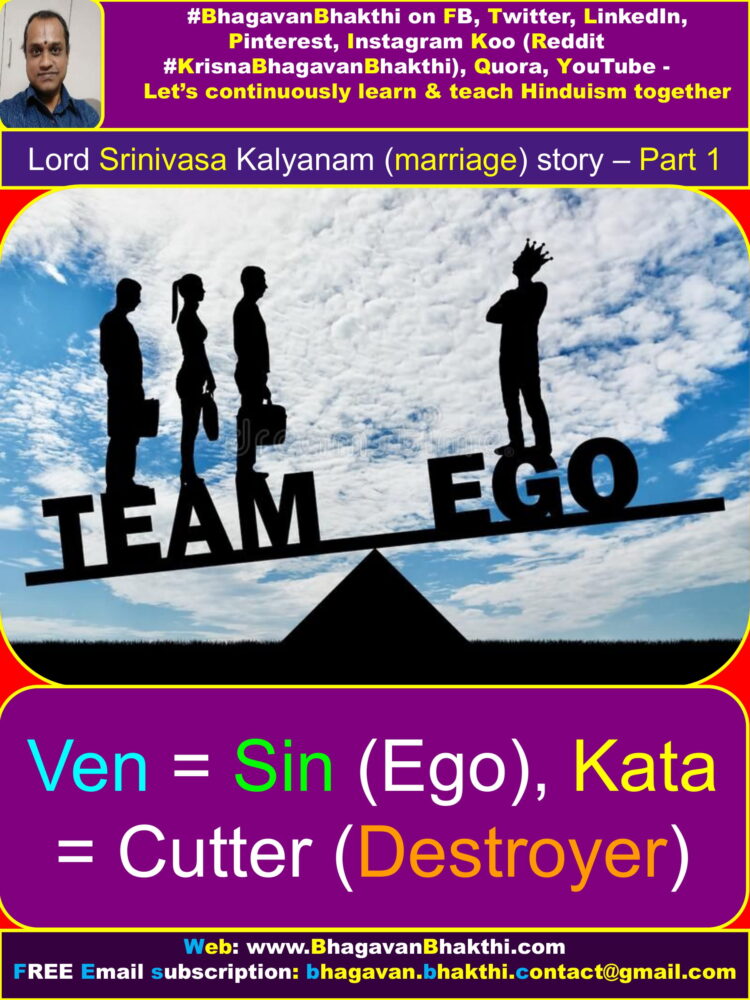
Thus, all the Devatas (Demigods) called it as Venkatachalam (Venkatadri).
One who does the smarana (remembering) of Venkatachalam (Venkatadri) in the morning will have all the punya (good deeds) of Sahasraavarti Sri Ganga Devi and Setu yatra (Rama Setu near Lanka).
Venkatachalam (Venkatadri) removes all our paapaas / sins. That is why it is called as Venkatachalam (Venkatadri).
This is the place where Lord Sri Brahma Deva gave a boon to Madhava Brahmana and with the sparsha (soft touch) all his sins were removed.
Darshana of Venkatachalam (Venkatadri) gives punya (good deeds) more than 1,000 times than Kashi and Rameshwaram.
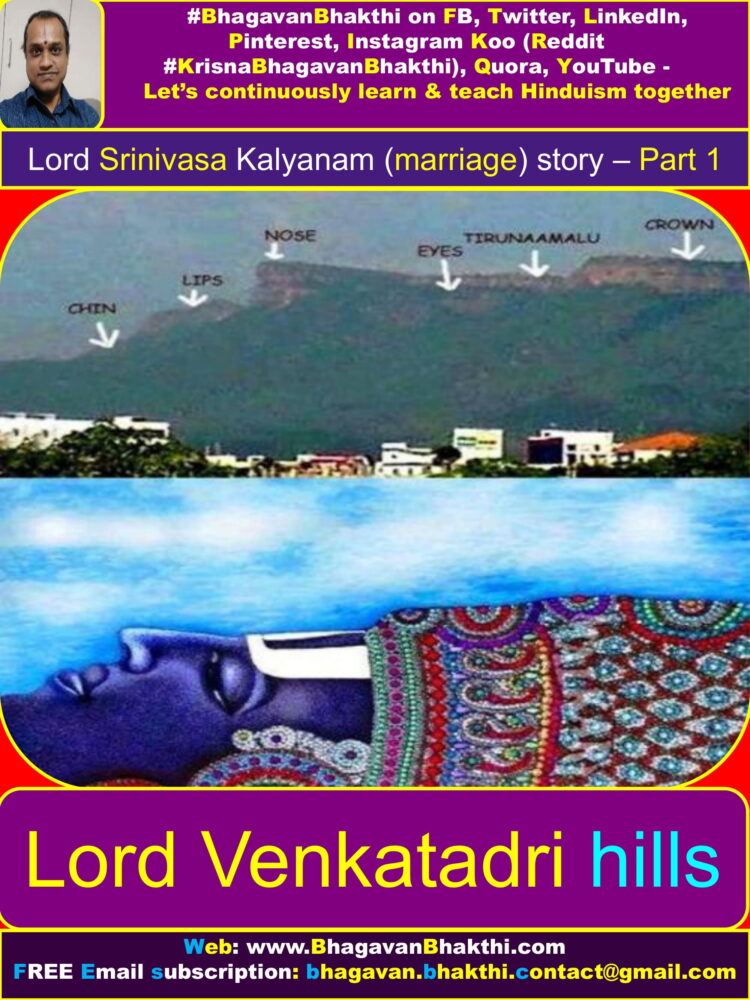
|| This is the end of first adhyaya of Sri Srinivasa Kalyanam ||
Dvitiya / Second Adhyaya
Seeradhvaja / Janaka Raja asked Rishi Shatananda, as how Lord Sri Vishnu came to Shesha parvata (hill) (Sheshachalam / Sheshadri) leaving Vaikuntha and what he did there?
Seeradhvaja / Janaka Raja also asked Rishi Shatananda to narrate the Tirthas in Shesha parvata (Sheshachalam / Sheshadri), Lord Sri Varaha Svamy form’s mahatmya / greatness, about Akasha Raja and his brother’s story.
Also Seeradhvaja / Janaka Raja asked Rishi Shatananda, how Goddess Sri Maha Lakshmi Devi became Akasha Raja’s daughter?
How did Lord Sri Vishnu became the son-in-law of Akasha Raja?
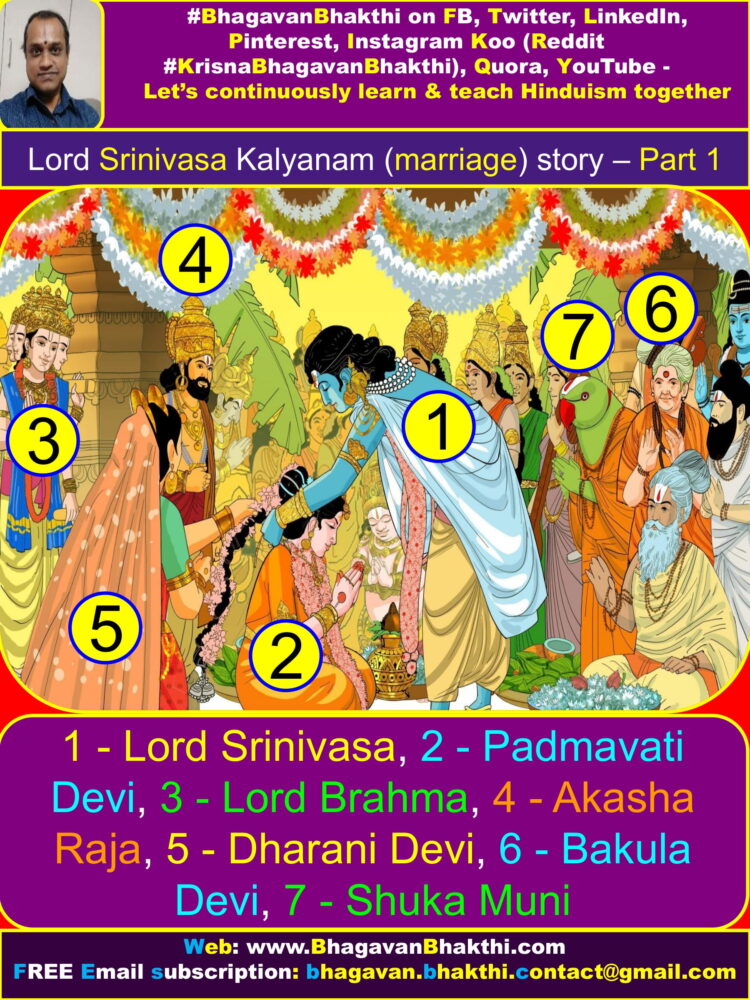
For this Rishi Shatananda replied as below:
Once upon a time, Muni shrestas Kashyapaadi (Great Kashyapa and other great Munis) Brahmarshi and also other Maharshis did a yajna near Ganga river basin.
During this period, Maharshi Narada came there and asked the Brahmanas as below:
Whom are they performing the yajna? Who is the best among Devatas? Whom are you doing meditation upon?, etc.
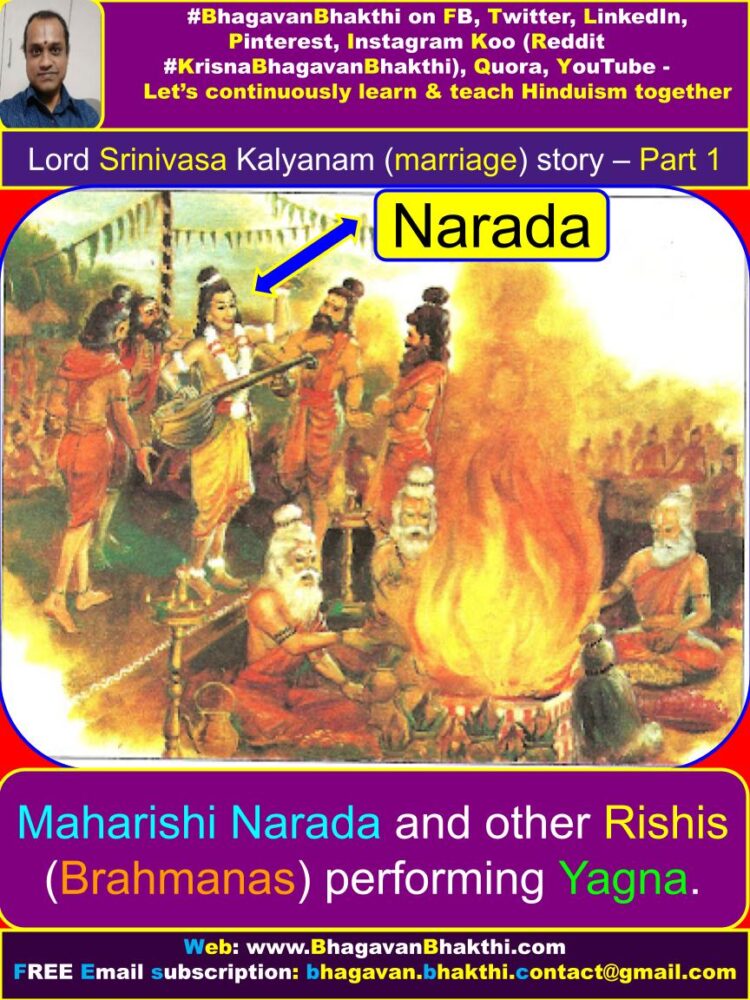
Here Maharshi Narada’s intention in asking as to who is Supreme God, is just to make aware to the entire loka / universe as to who is the sarvottama / supreme.
But he himself (Maharshi Narada) knows that Lord Sri Vishnu is the sarvottama / supreme.
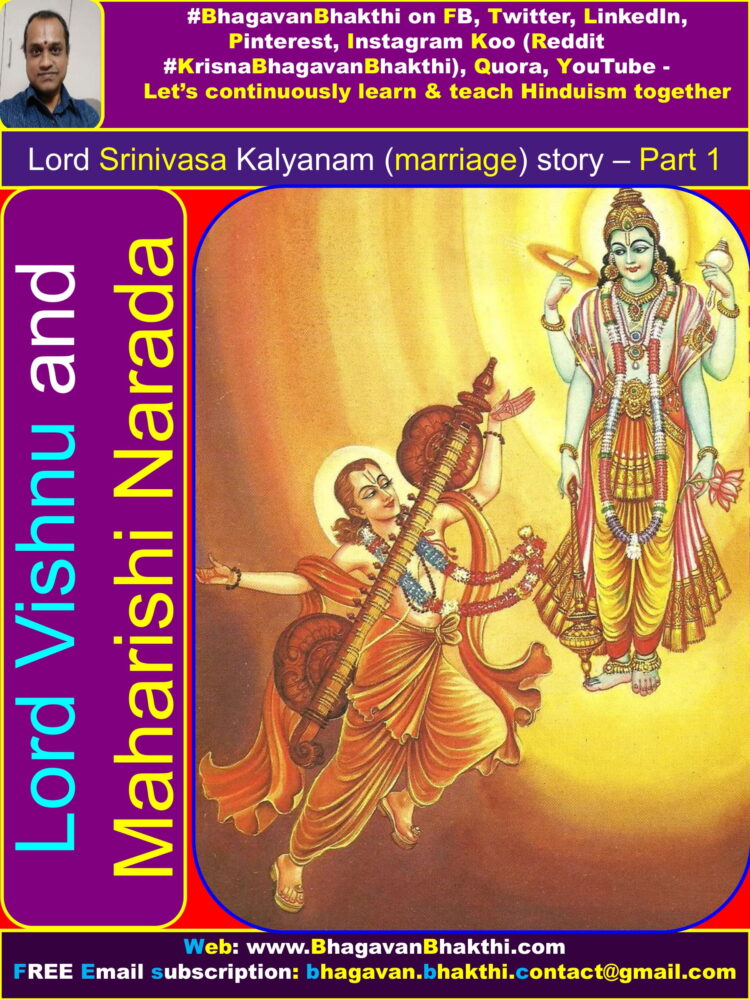
After this, all the Rishis, Munis nominated the Great Maharishi Bhrigu to find out who is the sarvottama / supreme amongst all Devatas.
Great Maharishi Bhrigu first went to Lord Sri Brahma Deva’s loka called Satya Loka.
At that time, Lord Sri Brahma Deva was doing the stotra (chanting) of Lord Sri Vishnu in all his chatur mukha / four faces.
Maharishi Bhrigu did shastanga pranama to Lord Sri Brahma Deva.
But Lord Sri Brahma Deva neither responded nor did Lord Sri Brahma Deva gave the aashirvada (blessing) to Maharishi Bhrigu.
This made Maharishi Bhrigu think that Lord Sri Brahma Deva does have some agnana (ignorance).
Thus, Maharishi Bhrigu cursed Lord Sri Brahma Deva not to have pooja on earth.
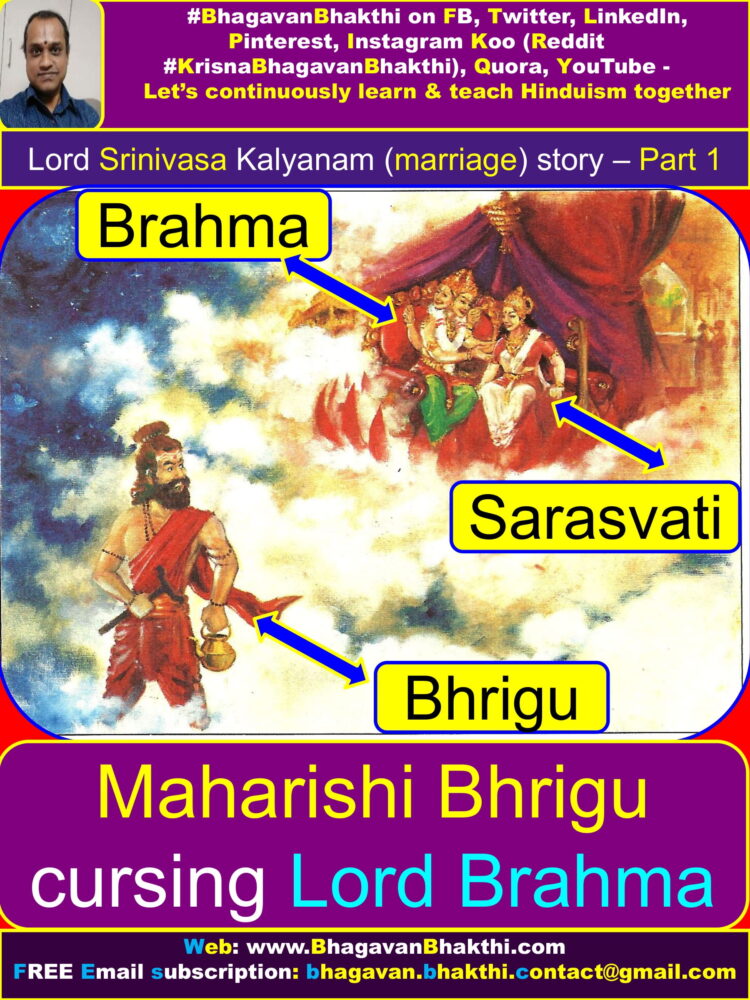
(Here one must always remember that curse given by Maharishi Bhrigu will not do any harm to Lord Sri Brahma Deva.)
[Having cursed Lord Sri Brahma Deva, Maharishi Bruhu lost all his tapa shakti (penance power).]
Off course Lord Sri Brahma Deva does not have pooja, but he does have Peeta pooja and aavarana pooja.
In Pushkara, the only place where Lord Sri Brahma Deva’s idol is there, pratima pooja is being done to him since a long time.
Moreover, as Sri Vayu Deva himself will become Lord Sri Brahma Deva in the next Maha Kalpa, Sri Vayu Deva being worshipped, it means that Lord Sri Brahma Deva also does have the pooja.
(Both Lord Sri Brahma Deva and Sri Vayu Deva are at the level in the taratamya / hierarchy of Devatas / Demigods).
From Satya Loka, Maharishi Bhrigu went to Kailasha parvata (hill) to see Lord Shiva (In his Tri Netra Pancha Mukha Rudra Deva).
Again here Maharishi Bhrigu was disappointed, as Lord Shiva was with Goddess Sri Parvati Devi and he was in the kaamasakta.
Goddess Sri Parvati Devi asked Lord Shiva to leave her as Maharishi Bhrigu has arrived.
This made Lord Shiva angry and he chased Maharishi Bhrigu to kill him.
But Lord Shiva was stopped by Maharishi Bhrigu who cursed him that he shall never have pooja to his idol, instead his pooja to be done only to his “Linga” form.
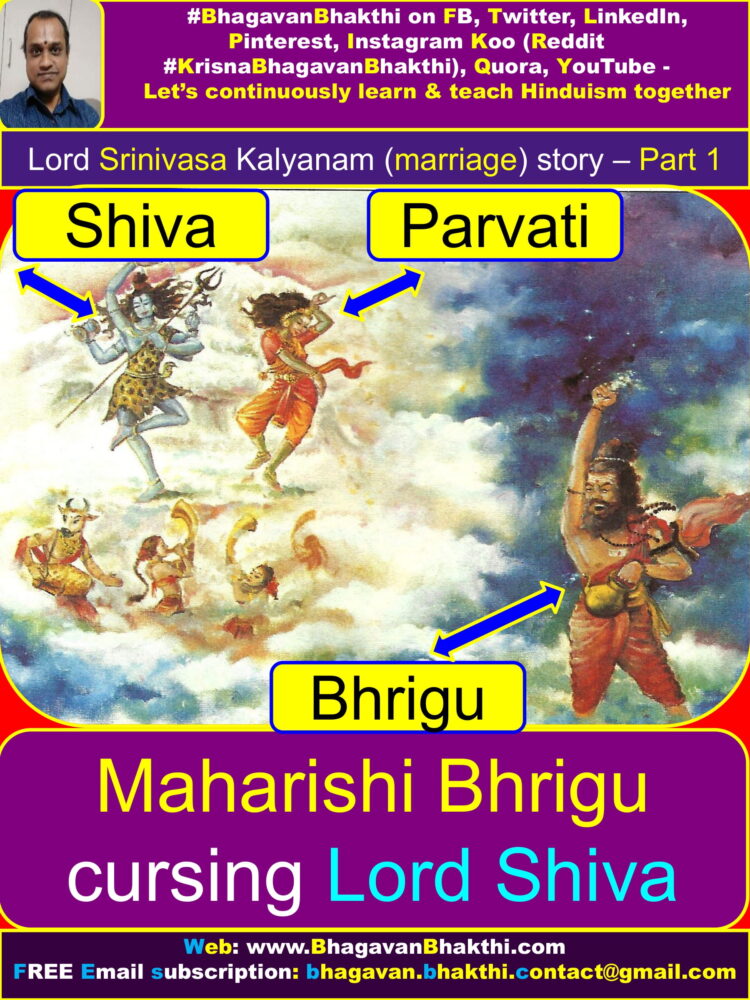
(Again here, we need to remember that this does not mean that Maharishi Bhrigu is superior to Lord Sri Brahma Deva or Lord Shiva.)
(Maharishi Bhrigu is in 15th in Kakshya / level, where Lord Sri Brahma Deva is in the 3rd Kakshya / level and Lord Shiva is in the 5th kakshya / level.)
(Both Lord Sri Brahma Deva and Lord Shiva wanted the entire world to understand that Lord Sri Vishnu is the sarvottama / supreme).
Just after cursing Lord Sri Brahma Deva and Lord Shiva, Maharishi Bhrigu went to Vaikuntha loka.
Here Maharishi Bhrigu saw that Lord Sri Vishnu had become sheshashayi (sleeping of Shesha Naga) and was being served by svayama Sri Maha Lakshmi Devi.
As Lord Sri Vishnu didn’t gave any importance to Maharishi Bhrigu, he kicked Lord Sri Vishnu’s vakshasthala (chest part) with his foot.
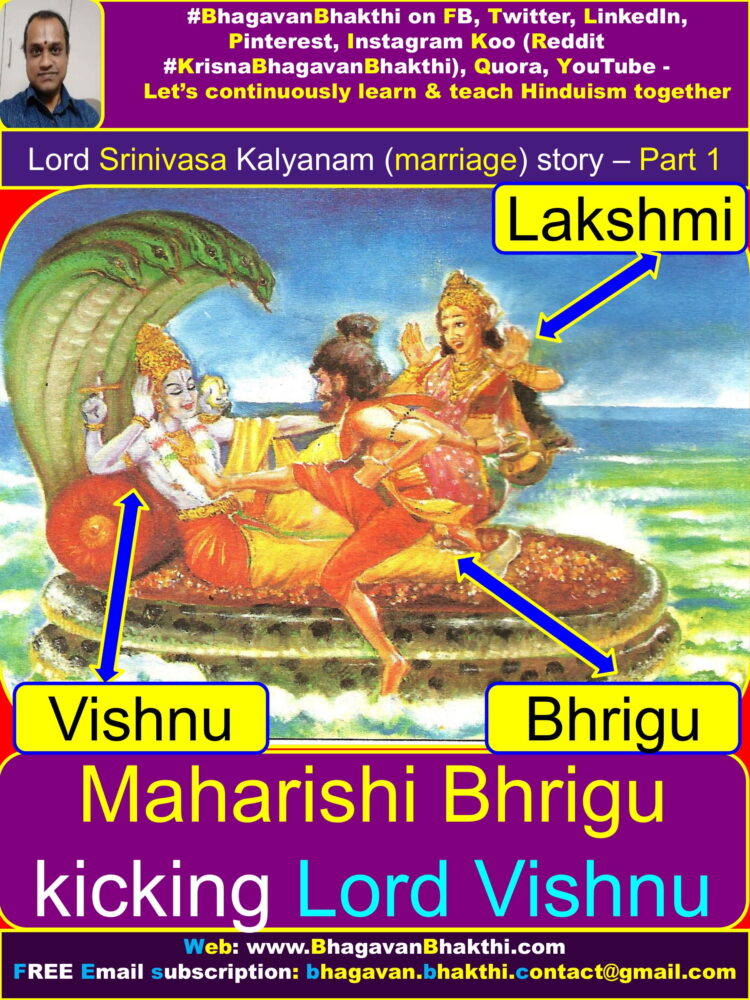
As soon as Maharishi Bhrigu kicked at Lord Sri Vishnu, Lord Sri Vishnu got up and did the namaskaras to Maharishi Bhrigu.
And Lord Sri Vishnu hugged Maharishi Bhrigu Rishi with pleasure and welcomed him to Vaikuntha Loka.
Lord Sri Vishnu asked Maharishi Bhrigu as to why did he kicked him, that too you have kicked the shareera (body), which is so strong as diamond, and your legs must be paining.
Lord Sri Vishnu asked Goddess Sri Maha Lakshmi Devi to bring some hot water, and did the paada prakshalana (Sprinkling the divine water of the foot) of Maharishi Bhrigu.
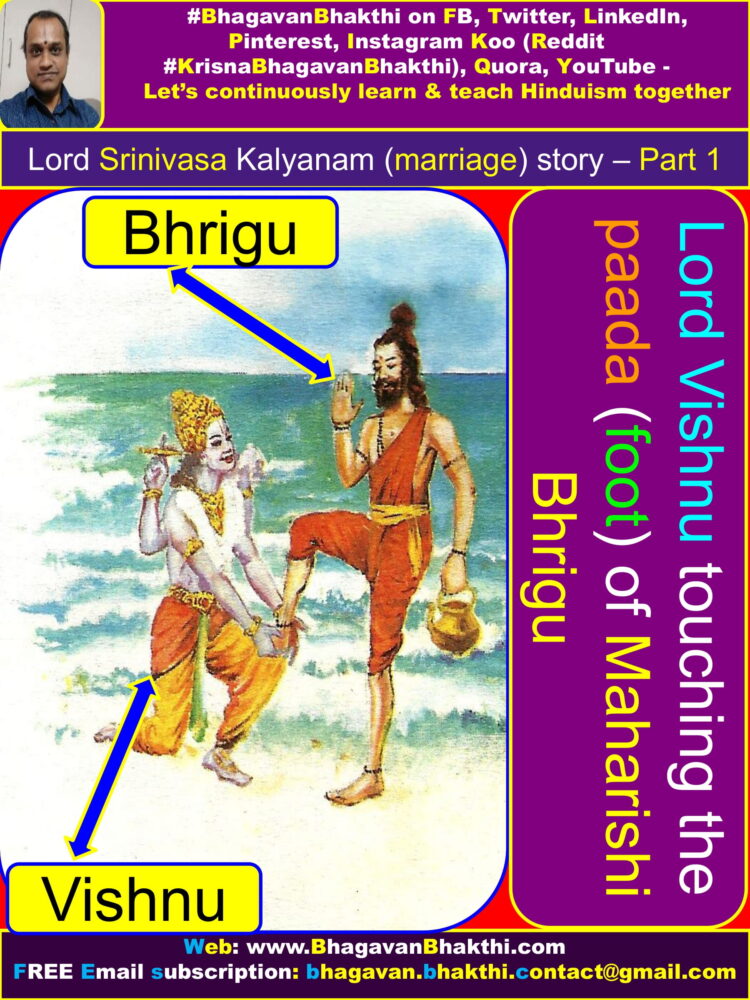
And Lord Sri Vishnu did the prokshana of that paadodaka on himself and on the Goddess Sri Maha Lakshmi Devi and on entire Vaikuntha.
Later, Maharishi Bhrigu reached Bhuloka (earth) and told the entire story to the world that Lord Sri Vishnu is the sarvottama /sarvashrestta
And all Rishis must do the samarpana of Yajna to Jaganniyamaka Lord Sri Vishnu only and not to any other Devatas (Demigods).
हरि: सर्वॊत्तम: साक्षात् रमादेवि तदंतरम् । विधिर्वायुस्तदन्ते च तदन्ते शर्वपूर्वका: ॥
Shloka meaning: Lord Sri Vishnu is Sarvottama and saakshaat Sri Rama Devi (Goddess Sri Maha Lakshmi Devi) is next to him in heirarchy (taratamya).
After Lord Sri Vishnu and Goddess Sri Maha Lakshmi Devi next comes Lord Sri Brahma Deva-Sri Vayu Deva, followed by Lord Sri Garuda Raja, Lord Sri Adishesha Naaga, Lord Shiva and other Devatas (Demigods).
Soon after Maharishi Bhrigu left Vaikuntha to reach Bhuloka, Goddess Sri Maha Lakshmi Devi told Lord Sri Vishnu that –
“Your Vakshasthana (a place called vaksha / chest part) is my place of stay in you.”
“In that place itself, Maharishi Bhrigu has kicked. Thus, I will not stay here any more and will leave for Karaveerapura”.
(This Karaveerapura is today’s Kolhapur in Maharashtra).
Thus saying this, Goddess Sri Maha Lakshmi Devi left Vaikuntha and stayed at Karaveerapura (today Kolhapur) only.
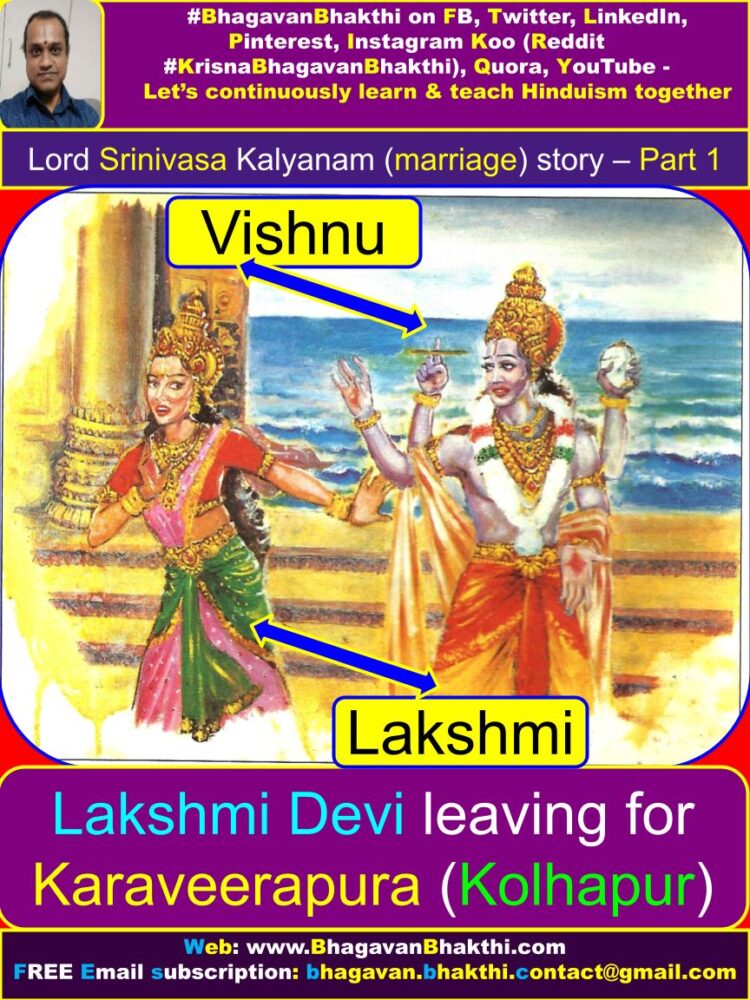
About Karaveerapura (This Karaveerapura is today’s Kolhapur in Maharashtra)
During Deva-Danava yuddha (Demigods and Demons fight), few asuras (demons) fearing about Devatas (Demigods), ran away in all directions.
Amongst them one asura (demon) who was called as ‘Kolla‘, reached Gomantaka parvata (hill) and was giving problems and causing nuisance to the people and especially to young ladies.
Also, this Kolla was kidnapping the young ladies.
As the problems and nuisance created by this asura (demon) and his group mates was up to the intolerant heights.
This made Maharishi Agastya and Maharishi Gautama to approach Lord Sri Vishnu and they requested Lord Sri Vishnu to kill that asura (demon) Kolla.
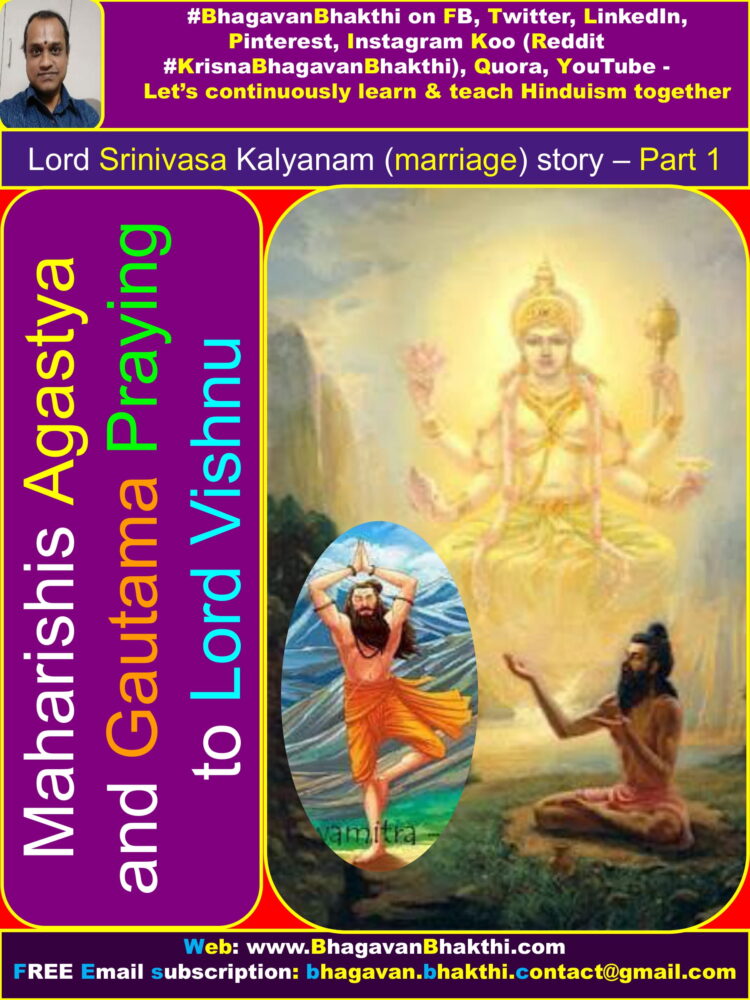
Lord Sri Vishnu ordered Goddess Sri Maha Laskhmi Devi to go to Karaveerapura and there Goddess Sri Maha Lakshmi Devi killed that asura (demon) Kolla.
(Here we should note that, this is only Rama (रमा)-Narayana’s leela or kridaa or pastime and it is pranaya kalaha for the loka mohanaarta – To teach lessons to common people.)
मायावी परमानंदं त्यक्त्वा वैकुंतमुत्तमं । स्वामिपुष्करिणी तीरे रमया सहमोदते ।
ಮಾಯಾವೀ ಪರಮಾನಂದಂ ತ್ಯಕ್ತ್ವಾ ವೈಕುಂತಮುತ್ತಮಂ | ಸ್ವಾಮಿಪುಷ್ಕರಿಣೀ ತೀರೇ ರಮಯಾ ಸಹಮೋದತೇ |
Thus, in this way, Lord Sri Vishnu reached bhuloka (earth), pretending to search for Goddess Sri Maha Lakshmi Devi and came Narayanadri parvata / hill near Swami Pushkarini.

In Narayanadri, Sri Adishesha Naga is in the parvata roopa (in the form of hill).
Venkatadri is Sri Adishesha Naga head, Ahobala parvata (hill) is the centre of Sri Adishesha Naga’s body,
Srisaila parvata (hill) is Sri Adishesha Naga’s tail, the entire Sheshachala is in the form of sarpaakriti (shape of a serpent).
This Parvata / hill has all plants, trees, fruits, etc., all animals like lion, tiger, Hamsa, sharaba, pig, gaja / elephant, parrot, kasturimriga, ashva / horse, Go / cows, all pushpas / flowers, etc.
All the trees are Devatas (Demigods), all the animals are Munis (Rishis) and all birds are Pitru Devatas.
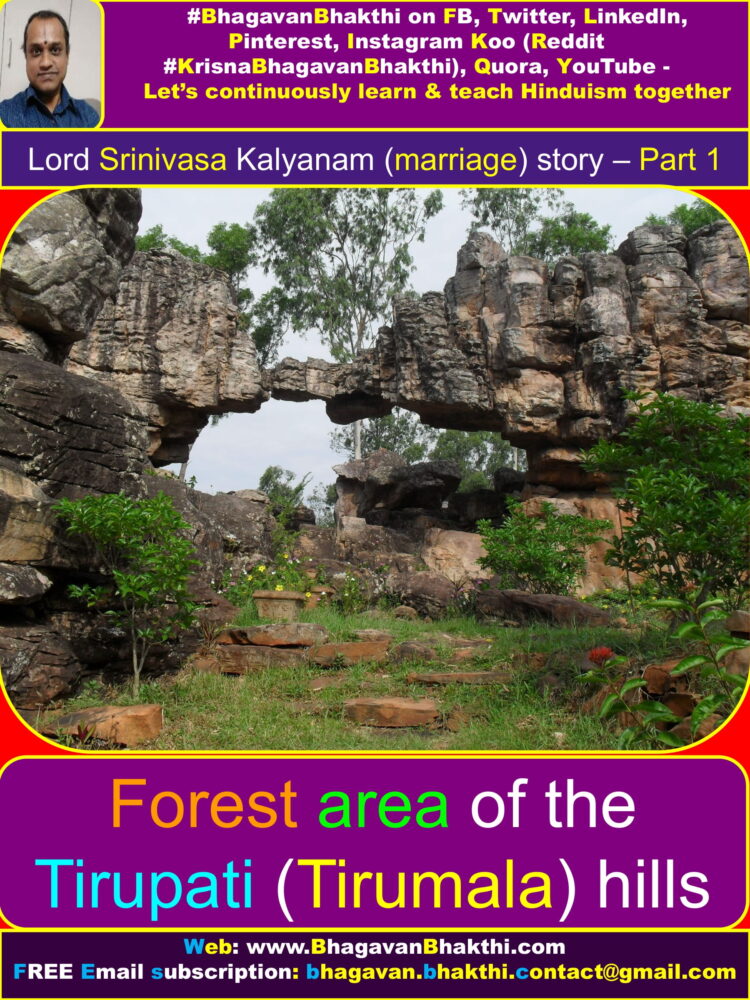
|| This is the end of second adhyaya of Lord Sri Srinivasa Kalyanam (marriage) ||
Related posts links are as given below:
Lord Srinivasa Kalyanam (marriage) story – Part 2 of Part 5
Lord Srinivasa Kalyanam (marriage) story – Part 3 of Part 5
Lord Srinivasa Kalyanam (marriage) story – Part 4 of Part 5
Lord Srinivasa Kalyanam (marriage) story – Part 5 of Part 5
To watch videos on #Hinduism #Sanskrit language, SUBSCRIBE to my YouTube channel from this below link:
#BhagavanBhakthi YouTube channel
Dear friends, if you need any clarifications about this post, kindly let me know, I will definitely try to answer all of them.
Also your one LIKE, one COMMENT, One Share, one SUBSCRIPTION is highly important.
This will help to know the quality of this content and also it will be helpful to know if any improvements is required for the content.
If you feel this content is useful to you and has helped you to improve your knowledge, kindly share this with your well-wishers.
Because “SHARING MEANS CARING”.
To receive FREE EMAIL SUBSCRIPTION about #BhagavanBhakthi, you can send an email to bhagavan.bhakthi.contact@gmail.com from your email ID.
NAMASTE!
Sri Gurubhyo Namaha
Sri Padmavati Devi sahita Bhagavan Sri Srinivaasaaya Namaha
Sri Krishnaarpanamastu
Subscribe / Follow us Share in Social Media
No words absolute speechless for the narration done
Dear Shilpa,
Dhanyavad for your valuable comment.
It’s all the blessings of Lord Vishnu.
Do continue reading my other posts to know about #Hinduism and #Sanskrit language from this link: About Hinduism and Sanskrit language (Bhagavan Bhakthi)
Keep in touch.
Shubhamastu!